















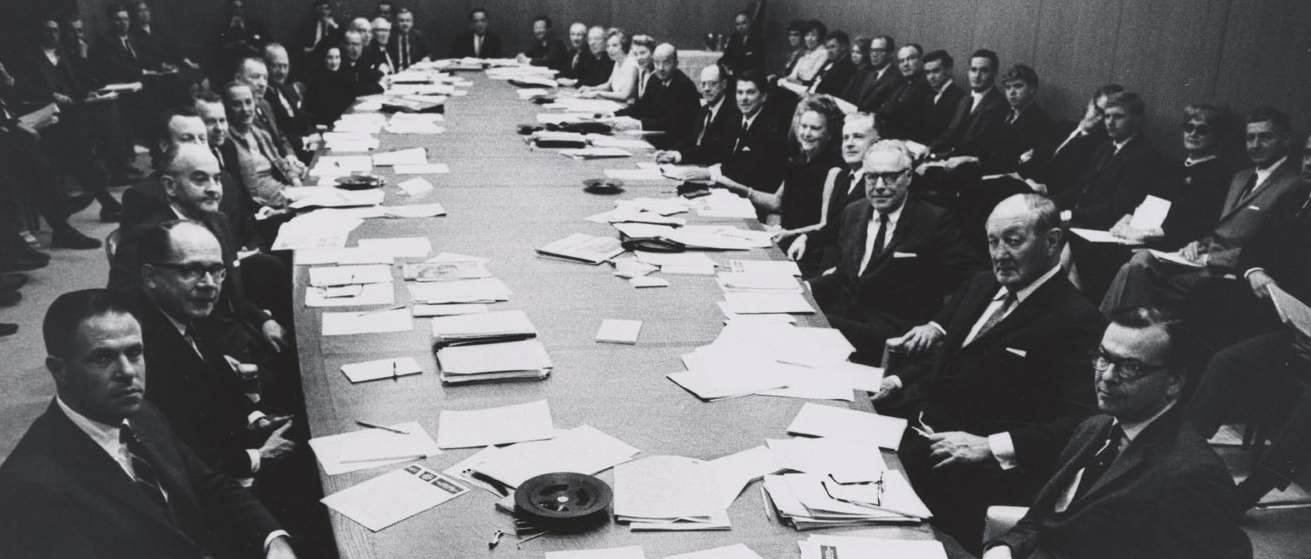

Fiat Lux
On the Same Page gives new students (and everyone else!) at Cal something to talk about. This year, we’re all on the same page viewing Ansel Adams’ photographs of the University of California in the 1960’s, and using these images from the past as a springboard to think about our present-day university and imagine the future university we would like to create.
Beginning in 2012, this program, which was created by the College of Letters and Science, has been expanded to include all new students and all faculty members at Cal. This means that over the summer each faculty member and each new freshman and transfer student will receive a copy of Fiat Lux, by Ansel Adams and Nancy Newhall. (Students who come to CalSO will receive their books at orientation; students who do not can pick theirs up when they arrive on campus, either at Convocation or in Evans Hall.)
Take some time to read through the book and look at the images, so you are ready for all the programmatic events and activities in the fall. On the Same Page presents many kinds of opportunities for new students to interact with faculty and continuing students around the year’s theme. This year’s activities will include several public events, one-time discussions led by faculty members, and a whole suite of interactive activities we are calling Fiat Lux Remix. We are also sponsoring a contest where you can submit your Remix creations. There will be a prize for the best submission, but perhaps more importantly the student submissions that present the most thoughtful and creative visions of the future will be shared with the Chancellor, UC President and Regents, among other influential audiences.
You will also find that our theme has permeated the curriculum: you will see that some of the Freshman Seminars for fall 2012 are related to Fiat Lux, and some of your regular classes may also feature images or ideas that relate to the theme. We want you to encounter elements of Fiat Lux wherever you go on campus this fall, and we will know we have succeeded when students and faculty who have only recently met find themselves buzzing about the photos, or about the past, present and future of our great university.
The Project

Fiat Lux (“let there be light”) is not only the motto of the University of California. It is also the name of a vast repository of photographs taken of the entire UC system nearly fifty years ago by Ansel Adams, one of the most famous photographers of the 20th Century. This extraordinary time capsule from the UC’s past has been chosen as the centerpiece for the 2012 On the Same Page program. Through our website (and the network of classes, talks, exhibitions, and databases that it weaves together), we invite you to explore the Fiat Lux collection, to look imaginatively and critically at our university’s history, and to participate actively in making its future. We are all stewards of the University of California.
Ansel Adams was commissioned in 1964 to create a portrait of the UC during a period of spectacular growth and expansion. At a reception at UC Santa Cruz, University of California President Clark Kerr rather abruptly proposed the idea of producing a photographic book to commemorate the upcoming centennial celebration of the university in 1968. He met Ansel Adams and the writer Nancy Newhall at the door, pointed to both of them and said, “You’re going to do the centennial book on the university.” Adams replied, “Well, why not?”[1]
Adams and Newhall were asked to create a book that would “capture and relate in photographs the appearance and spirit of the campuses and activities of the University of California . . . . It is intended that your book will emphasize the prospective view for the university and that it will present a sense of the opportunities which lie ahead.”[2] In asking Adams and Newhall to create in images and words a prophetic vision of the future, Kerr challenged them to project, as far as possible, “the next hundred years.”[3] This was an impossible expectation, of course, since one cannot literally photograph the future. Yet Adams and Newhall took Kerr’s challenge as their general directive.[4] The result was a project that spanned four years, and produced over 6000 images–all of which the UC Regents own. After Adams’ lifetime devotion to Yosemite, “this was probably the biggest single project of his life,” according to Clark Kerr.[5]
For three years, both Adams and Newhall toured the state, visiting nine campuses and dozens of the UC’s scientific field stations, reserves, observatories, and agricultural outposts. They produced in 1967 a book called Fiat Lux for the UC’s centennial. The photographs in the Fiat Lux collection capture the sense of optimism and even hubris that guided these heady days of UC expansion. One sees modernist buildings plunked down in sometimes quite barren locations, cerebral outposts in arid California landscapes, or in the case of Santa Cruz, a new campus emerging from the ruins of a dilapidated old farm. In the great surge of planning and expansion inaugurated by Clark Kerr’s legendary 1960 California Master Plan of Higher Education, the university toiled to prepare for a “tidal wave” of new student enrollments. The university expected it would need to double its capacity in a single decade: in actuality it tripled. “On many campuses,” Adams and Newhall said, “the University was being torn down, rebuilt and expanded at a rate unbelievable, perhaps, except by eyewitnesses. Buildings were being demolished and carted away. Bulldozers were excavating new sites and roads, and carving out new landscapes. Cranes were lifting up girders and swinging shapes of precast concrete into place. . . . Visually, the University was in metamorphosis.”[6]
Both Adams and Newhall recognized that “there has never been a more illuminating period through which to view the University.”[7] Now, fifty years later, the University of California faces some of the most difficult times in its history. The public good in California is imperiled, and the university, as a public institution, is no exception. While there have been fiscal emergencies throughout the UC’s 144-year history, the present crisis is of historic proportions, with schemes for privatization as well as calls for disaggregation of campuses and schools voiced with unparalleled frequency and resonance. How the UC weathers this epoch will have profound implications for the State of California.
The 2012 On the Same Page program invites our campus community and, indeed, the larger California public to participate in expansive conversations about the University of California’s vision, public mandate, and future prospects.[8] This website provides multiple ways to learn about the archive, experience and respond to the Fiat Lux centennial book and Adams’ photographs, and to remix, re-imagine and remake both the photographs and the institution they represent. Fiat lux redux!
[1] Conversations with Ansel Adams, an interview conducted by Ruth Teiser and Catherine Harroun, Regional Oral History Office, The Bancroft Library, University of California, Berkeley, conducted in 1972, 1974, and 1975, p. 545. http://www.archive.org/stream/convanseladams00adamrich/convanseladams00adamrich_djvu.txt
[2] Letter of understanding from Earl C. Bolton to Ansel Adams, October 21, 1964, The Bancroft Library, CU 5.9, box 17, folder 1.
[3] Ansel Adams and Nancy Newhall, Fiat Lux: The University of California, New York: McGraw-Hill, 1967, p.
[4] Ibid, p. 7.
[5] Quoted in Melinda Wortz, Ansel Adams: Fiat Lux, The Premier Exhibition of Photographs of the University of California, Irvine: University of California, 1990, p. 13.
6 Ibid.
[7] Adams and Newhall, Fiat Lux, p. 2.
[8] See also Catherine M. Cole, “Picturing our Future,” Townsend Center Newsletter, February/March 2012, http://townsendcenter.berkeley.edu/article37.shtml.
The Book
 Commissioned for the observance of the one hundredth anniversary of the establishment of the University of California in 1968, Fiat Lux by Ansel Adams and Nancy Newhall celebrated the event with a perceptive, artistic statement about the University itself, and about its reach into the lives and surroundings of the people it serves. This book was especially designed by Adams, Newhall and bookmaker Adrian Wilson to be experienced at a particular scale and size. Because this original 1967 edition is now out of print, On the Same Page, in collaboration with UC Press, has created a 2012 facsimile edition for all incoming students and current faculty, a reprint that approximates the original in terms of size and overall layout. We believe that even in the digital age, there is still a place for the material object of the book, especially a book that was so carefully and thoughtfully designed.
Commissioned for the observance of the one hundredth anniversary of the establishment of the University of California in 1968, Fiat Lux by Ansel Adams and Nancy Newhall celebrated the event with a perceptive, artistic statement about the University itself, and about its reach into the lives and surroundings of the people it serves. This book was especially designed by Adams, Newhall and bookmaker Adrian Wilson to be experienced at a particular scale and size. Because this original 1967 edition is now out of print, On the Same Page, in collaboration with UC Press, has created a 2012 facsimile edition for all incoming students and current faculty, a reprint that approximates the original in terms of size and overall layout. We believe that even in the digital age, there is still a place for the material object of the book, especially a book that was so carefully and thoughtfully designed.
For wider circulation and access to the text among students, faculty, staff and the larger public as well as for the visually impaired, we have provided a machine-readable PDF of Fiat Lux.
This republication in both material and digital form is an invitation to reconsider our inheritance and to re-imagine our institution’s future.
Visual Literacy
“Perhaps the old literacy of words is dying and a new literacy of images is being born. Perhaps the printed page will disappear and even our records be kept in images and sounds.” -Nancy Newhall, Aperture, 1952[1]
The Fiat Lux book exemplified a genre of photography book that Nancy Newhall is credited with inventing: the “spread book” in which photographs and words are carefully calibrated and matched, with picture size and placement shifting in relationship to words and overall design. The effect of such a book, as Ansel Adams described in a letter to a UC administrator, was that each spread within the book must “read well, look well and ‘feel’ well. The best ideas in the world must be tailored to the total design. This is quite different from a book with continuous text, and pictures introduced on an occasional basis.”[2] Newhall and Adams, who had worked together on several previous books, aimed with Fiat Lux to produce not a documentary photographic book about the university but rather an expressive, poetic, and personal interpretation. “This is a portrait by an artist rather than an essay by a photojournalist,” said one observer.[3]
The overall thrust of Fiat Lux emphasized the relationship of the University to the people of California, as is evident in the book’s opening line: “To look at the University of California is to look at California itself–its land, its people, and their problems–into the civilization rushing towards us from the future. There are few aspects of California . . . with which the University is not concerned.” They favored resonant images, rather than spectacular ones; evocative images over those tied to comprehensiveness or making documentary statements. Words and photos were chosen and presented in a way meant to produce a “profound emotional experience,” in the words of Newhall.[4]
Today, the Fiat Lux images and book often produce emotional reactions, and not all of these are positive. Some contemporary observers react to the images quite negatively, finding them disturbing, dystopian, monumental, and uncritical of their modernist and masculinist sensibilities. Others are puzzled by the relative absence of students in the photographs, an absence that was also noted at the time of the book’s publication in 1967 when J.R.K. Kantor of The Bancroft Library said, “Fiat Lux is much better than I expected. In fact, it is really impressive in its telling the story of the University’s accomplishments as a research institution — this is good public relations, for it shows the public what it has gotten for what it has paid. I’m afraid, though, that Adams and Mrs. Newhall have managed to overlook the entire student-faculty reality, but perhaps this is not to their taste.”[5]
The question of why there are so few students is an interesting one, and perhaps one answer might be found by reading Clark Kerr’s Godkin lectures delivered at Harvard in 1963, the very year he commissioned the Fiat Lux project.[6] These lectures also presented what many found to be an unsettling portrait of the undergraduate college experience, especially within the new model of the research university that Kerr termed the “multiversity.” Berkeley’s Free Speech Movement reinterpreted Kerr’s “knowledge industry” as a “knowledge factory,” and Mario Savio called upon students to throw their bodies upon the gears of the machine. Interestingly, machines loom large in Adams’ rendering of Kerr’s University of California from half a century ago. Machines often upstage, entrap and even replace researchers altogether.
While Fiat Lux was, for Adams, a work for hire, can we still see in these images a critical sensibility expressed by the artist? What attitude do these photographs and the text and layout in the book have towards the university? What assumptions about knowledge or learning are represented here? The UC was known in this period for its involvement in mass public education, big agriculture and defense. How are these aspects represented in Fiat Lux? How might your own portrait of the future of the University of California differ from what Adams and Newhall have presented? We are only half way into the century they were asked to imagine. Should we, at this moment, imagine our future differently? Are there features of the expansive vision for a public university system represented in this archive–one in which the UC appears, according to Clark Kerr, as the “Yosemite of higher education”–that we believe ought to be preserved and conserved?[7] What is your picture of the future? Adams and Newhall dedicated their project to those who will make the future. That’s us!
[1] Quoted in Nancy Newhall: A Literacy of Images, foreword by Deborah Klochko (San Diego: Museum of Photographic Arts, 2008), 4.
[2] Letter from Ansel Adams to Verne Stadtman, January 31, 1967, The Bancroft Library, CU 5.9, box 17, file 1.
[3] Memo from Verne Stadtman to UC Vice President Sorensen, February 10, 1967, The Bancroft Library, CU 5.9, box 17, file 3.
[4] Letter from Nancy Newhall to Verne Stadtman, March 29, 1967, The Bancroft Library, CU 5.9, box 17, file 3.
[5] Memo from J.R.K. Kanto, University Archives, The Bancroft Library, to Verne Stadtman, December 15, 1967, The Bancroft Library, CU 5.9, box 17, file 4.
[6] These lectures were later published as The Uses of the University, Fifth Edition, Cambridge: Harvard University Press, 2001 (originally published 1963).
[7] Quoted in Melinda Wortz, Ansel Adams: Fiat Lux, The Premier Exhibition of Photographs of the University of California, Irvine: University of California, 1990, p. 11.
Original Jacket Copy
The creators of this distinguished volume are well known to those who love and admire photography. Californians and conservationists are particularly familiar with them because of their successful collaboration on such books as Death Valley, 1954, The Pageant of History in Northern California, 1954, Yosemite Valley, 1959, and This is the American Earth, 1960.
Biographies of the Artists
ANSEL ADAMS, master photographer, is one half of this remarkable partnership. Created by other men, pictures may speak 1,000 words: by Ansel Adams they sing songs. That may be no accident, for, in his youth, Adams studied the piano and aspired to a concert career. But his interest in photography, begun at the age of 14, trained under the tutelage of a San Francisco photo-finisher, and inspired by a warm acquaintance with famous California artists, poets, and photographers, eventually won out as the dominant pursuit in his career. Another life-long interest, mountaineering and conservation, gave his photography much of its characteristic subject matter and point of view. A portfolio on Parmelian Prints of the High Sierras, launched his career as a photographer in 1927 and has been followed by an imposing list of exhibitions, books, and portfolios that have appeared with regularity to the present time. His “straight” or pure photography techniques are shared with other photographers in his own books on the art and in classes and lectures throughout the country. He founded the first department of photography in the California School of Fine Arts, now the San Francisco Art Institute, affiliated with the University of California.
NANCY NEWHALL, trained as a painter, became interested in photography and photographers after her marriage to Beaumont Newhall in 1936. After two years of research for a biography of Alfred Stieglitz in 1941-42, and three more as acting curator of photography at the Museum of Modern Art in New York, she became aware of the new dimension that could be achieved when words and images are, in her words, “conceived together in synesthetic sequence” for books and exhibits. She concluded that selection, arrangement, and textual amplification of photographs, while influenced by the artist whose work is presented, constitute creative expression of a form that is undoubtedly an art in itself. With this insight she has collaborated with Ansel Adams, Paul Strand, Edward Weston and other photographers, to produce memorable volumes.
ADRIAN WILSON, designer and typographer, entered the graphic arts through the stage door, printing extraordinary posters and programs for San Francisco’s post-war theaters. Limited editions of fine books soon followed, as well as commissions for book designs from the University of California Press. In 1958 he wrote, printed and published widely acclaimed Printing for Theater. After a year’s sojourn to Europe studying the work and methods of leading designers and printers, he established his Tuscany Alley book design studio on Telegraph Hill in San Francisco. From it have emerged award-winning pictorial and art books, scholarly texts, cookbooks, corporate reports, bibliophile editions, etc. He has also taught at the University of California School of Librarianship and at the San Francisco Art Institute.
The Photos
 Cameras are so ubiquitous today that it’s hard to imagine the circumstances in which Ansel Adams worked. During most of his lifetime, photography required rarified equipment that few could afford and even fewer knew how to use. Ansel Adams was one of the great masters of the art of photography, and he was also an inventor of techniques such as the “zone system” and “previsualization” that continue to influence photographers today.
Cameras are so ubiquitous today that it’s hard to imagine the circumstances in which Ansel Adams worked. During most of his lifetime, photography required rarified equipment that few could afford and even fewer knew how to use. Ansel Adams was one of the great masters of the art of photography, and he was also an inventor of techniques such as the “zone system” and “previsualization” that continue to influence photographers today.
In order to experience the Ansel Adams Fiat Lux images of the University of California and to participate in the On the Same Page program, there are several avenues of access. Some of these prioritize appreciation of the precision and nuance of the original work of art, others favor accessibility to a wider audience and/or access to the larger collection of images that extends beyond 170+ images chosen by Ansel Adams and Nancy Newhall for inclusion in the 1967 Fiat Lux book. We invite you to explore all of the points of access listed below, in addition to browsing the book. Students will also have the opportunity to download images and interact with these creatively and imaginatively through course projects and Remix prompts listed on this website.
Before the word “remix” became so popular in our digital age, Ansel Adams anticipated its possibilities. As an accomplished pianist, Adams believed that a photographic negative, like a musical score, should be made available to others–especially students–to reinterpret and re-perform. To hear Adams own thoughts click here for a youtube video. The On the Same Page “Remix” projects on this website invite you to do just that: to perform Adams’ photographic scores and, in doing so, to create astounding new visions and interpretations of the photos and the university they represent.
The Bancroft Library: To fully appreciate the work of Ansel Adams, there is no substitute for seeing the fine prints created by the artist. Digital reproductions or publications in books are often vastly diminished in quality, many generations removed from original and able to capture only a fraction of the resolution and nuance found in prints created by the artist. The very best way to see the images is to come to The Bancroft Library when the exhibit “Fiat Lux Redux: Ansel Adams and Clark Kerr” The Fiat Lux Redux exhibit at the Bancroft Library will run from September 27, 2012 through February 28, 2013. The Bancroft Gallery open hours are 10:00 a.m. to 4:00 p.m. Monday through Friday. The Gallery will also be open October 7, for Homecoming weekend, from 10:00-3:00.
The Bancroft has a set of over 600 signed fine prints from the Fiat Lux project. The exhibit will display several dozen of these, while also contextualizing the Fiat Lux project within a larger vision for public higher education in California. Former UC President Clark Kerr, who commissioned Adams and Newhall to make this book, is also the architect of California’s famous Master Plan for Higher Education and was responsible for opening three of the nine campuses that were then in the UC system.
California Museum of Photography: While the 605 Fiat Lux fine prints made by Adams were deposited with Berkeley’s Bancroft library, his negatives for the project–over 6,000 of them–now reside with the California Museum of Photography (CMP) at UC Riverside. CMP has an online searchable database of 1,700 negative scans from the Fiat Lux collection. While the images are low resolution, giving only a remote sense of the production values of the fine prints, one can see in this database the larger scope of what Adams shot and consider what stories can be told from images not included in the book. What ended up “on the cutting room floor” and why?
Fiat Lux Remix Image Site: Berkeley’s Center for Digital Archaeology has created an image database from scans of the Fiat Lux book that were used to make the 2012 facsimile reprint edition. This database thus contains all the images in the book, along with accompanying captions. The site allows users to select images for use in the Fiat Lux Remix projects. These images are available to download for anyone with a CalNet ID.
Fiat Lux Remix: Engage with the 2012 theme
Take Five
Take Five is an invitation to curate a mini-exhibition of Fiat Lux photographs or images that you create yourself depicting the UC’s future.
“Take Five” is a series of filmed interviews with UC faculty, staff, alumni, and students as well as members of the general public in relation to the Fiat Lux photographic collection. We ask our narrators to select five images from the collection that speak to that person–for whatever reason. Sometimes narrators’ choices arise out of their disciplinary focus, or their personal views about education or the UC. Other times their choices are quite personal. We then edit each interview down to about five minutes, and the finished pieces will appear both on this website and also in the “Fiat Lux Redux” exhibition at The Bancroft Library in the Fall 2012.
Designed to provoke conversations about the past, present and future of the University of California, “Take Five” is an art-based social practice designed to catalyze conversations about what we see and don’t see in these images, about what we like and want to keep alive from our institution’s past, and also about what might be wrong and need to be changed. It’s also about our aspirations: what sort of pictures of the UC’s future do we want to see?
Take Five Videos
Ansel Adams, Photographer
On the FIAT LUX Commission: In this video, Ansel Adams discusses the culmination of the FIAT LUX photographic book which went into production in January 1967–the very month that California Governor Ronald Reagan presided at the UC Regents meeting at which UC President Clark Kerr was fired. “The reactionary people took over and started cutting the most vital parts out,” said Adams. “It wasn’t that they just would reduce expenditures, but they reduced morale.”
On Contrivance
On a Close Call
The Conclusion
Berkeley Community
Nezar AlSayyad, Architecture
Aaron Bady, English: Libraries and Photobooth Banners
Michael Ball, Patricia Lee, and Vanessa Matalon, Students from a Photography Class
Brian Barsky, Electrical Engineering and Computer Sciences
Gray Brechin, Geography
Julia Bryan-Wilson, Art History
Georgina Kleege, English
Ken Light, Photographer
Dante Noto, Educational Partnerships, UC Office of the President: Breadth of the UC and Hearts and Minds
Gina Patnaik, English
Michael Pollan, Journalism
Leigh Raiford, African American Studies
Mark Richards, Earth and Planetary Science
Alan Ross, Photographer
Sheldon Rothblatt, History
Sue Schweik, English
Richard Walker, Geography
Anne Walsh, Practice of Art
Interludes
Charter Day 1964
Geology Field Trip (Zone System)
Sugar Beets
Prompt
Make your own “Take Five” by selecting five images from the Fiat Lux Image Remix Site or taking your own photographs of the UC’s future. Put the images in a Powerpoint and make an audio track for the show that explains your image choices. Alternatively, write a paper that does the same thing. When your project is complete, submit to the On the Same Page contest.
Instructors
Kwame Braun is a documentary filmmaker who teaches courses on video production in several departments at Berkeley: Anthropology, Art Practice, Film Studies, and Theater, Dance and Performance Studies.
Catherine M. Cole is a Professor of Theater, Dance and Performance Studies. Her research focuses on how performances participate in social transformation for cultures and communities.
Collective Discovery Engine
The Fiat Lux Collective Discovery Engine is an experimental new social media interface that uses the wisdom of the crowds.
The engine provides a participatory visual interface to the Fiat Lux collection that combines your ratings and comments with those of others to identify the most interesting images and comments.
This experimental new social media interface for images visualizes a collection of photographs of the University of California taken in the early 1960’s by renowned photographer Ansel Adams. It is a self-organizing system that arranges photos based on data about them. Users can interact with these images by rating and leaving textual comments. The system employs new algorithms to analyze ratings to identify and highlight the most insightful images and comments. The system is based on the Opinion Space interface developed at UC Berkeley.
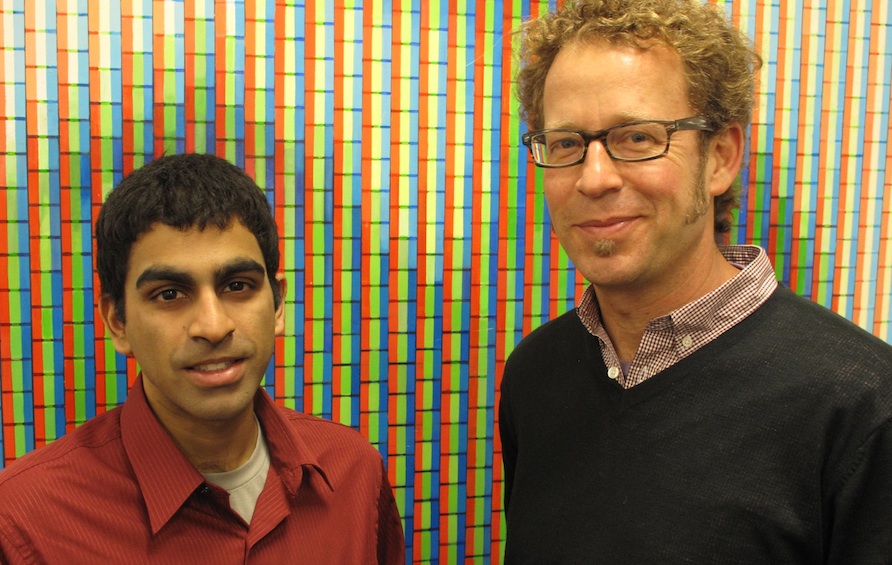
Instructors
Ken Goldberg is the craigslist Distinguished Professor of New Media, and a professor of IEOR at UC Berkeley, with appointments in EECS, Art Practice, and the School of Information.
Sanjay Krishnan has worked with Prof. Goldberg since 2010, and is currently pursuing an M.S in EECS at UC Berkeley.
Photo And Video Mash Up
See how graduate students in a hands-on introductory video production seminar used the Fiat Lux images to explore relationships between the past and the present in the transforming life and politics of UC Berkeley.
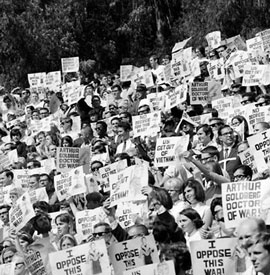 In Spring 2012, graduate students enrolled in “FILM 230: Graduate Video Production Seminar” made these videos exploring the Fiat Lux images as part of a hands-on introductory video production seminar. The class learned how to use digital video cameras, sound, lighting, computer editing technologies and filmmaking techniques such as interviewing, digital compositing, animation, and the use of archival materials as part of their creative and scholarly research. Bringing critical and research skills to their filmmaking, the class made short essay films using Adams’ photographs to explore relationships between the past and the present in the transforming life and politics of UC Berkeley.
In Spring 2012, graduate students enrolled in “FILM 230: Graduate Video Production Seminar” made these videos exploring the Fiat Lux images as part of a hands-on introductory video production seminar. The class learned how to use digital video cameras, sound, lighting, computer editing technologies and filmmaking techniques such as interviewing, digital compositing, animation, and the use of archival materials as part of their creative and scholarly research. Bringing critical and research skills to their filmmaking, the class made short essay films using Adams’ photographs to explore relationships between the past and the present in the transforming life and politics of UC Berkeley.
Prompt
If you have access to a digital video camera (even through your cell phone) and a basic computer-editing program, you can make your own video “mash-ups” and put your personal experiences of UC Berkeley into the Fiat Lux picture! Import the photos from our Fiat Lux image hub, other found footage from the internet, interview yourself, write a narration and make a short video voicing your opinions, ideas and impressions of UC Berkeley then and now! Submit your finished work to the On the Same Page contest, or material forward for a screening through the “Fiat Lunch” class.
Instructors
Jeffrey Skoller is Associate Professor in the Department of Film & Media.
Student Filmmakers from Film 230 are Robert Alford, Renee Pastel, Meg Alvarado Saggese, James Anderson, Sahar Khoury and Sofie Lykke Stenstrop, graduate students from the departments of Film & Media, Rhetoric, History, and Art Practice
Write The Story
Try your hand at some of the approaches professional playwrights like Philip Kan Gotanda and Joshua Williams might take to Fiat Lux.
Playwrights often draw on archival material like Ansel Adams’ photographs to create interesting characters and storylines. Try your hand at some of the approaches professional playwrights like Philip Kan Gotanda and Joshua Williams might take to Fiat Lux. We’ve provided a few prompts – inspired, in part, by the photographs you see above – but you should be as creative as you want to be. Let nothing hold you back!
- Choose a portrait of a single person from the Fiat Lux collection. If you’d like, you could go with Dr. Sudha Rao, the scientist in the photograph above. Try to imagine that you’re that person and you’re posing for Ansel Adams, the famous artist. Remember that he used different camera technology than we do today, and that people who posed for him often had to hold still for quite a long time. What’s running through your head as he adjusts his camera and takes the shot? Write a 200-word inner monologue from the point of view of the character you’ve imagined. What do you, as this person, think about Ansel Adams? About the U.C.? About California, or the United States, or the world?
- Choose a person you find particularly compelling in one of Adams’ photographs. You could work from one of the images we’ve provided, or another one altogether. Imagine this person going home at the end of the day. Who does she (or he) go home to? Her roommate? Her brother? Her landlord? Her son? Imagine a conversation between your character and this other person. What would your character tell her roommate or her brother or whoever it is she comes home to about posing for Ansel Adams? What would she tell this person about her day in general? Remember that these photographs were taken in the late 1960s. Try to tie the dialogue you come up with to what was happening in the world at that time – like the Civil Rights Movement, the Space Race, the Vietnam War, and so on. Write a 500-word scene that captures the conversation you imagine.
- Pick a person from one of Adams’ photographs and try to imagine him (or her) as he (or she) is today. Remember that many of the people in these photographs are still living. Imagine your character sitting down with his granddaughter, or his partner, or a nurse at his nursing home facility. Imagine him trying to recall the day he was photographed by Ansel Adams. How would he describe the experience? How would the other person respond? What questions might this other person have about California in the 1960s? What comparisons would your character draw between California as it was then, California as it is now and California as it might be in the future? See if you can come up with 500 words of dialogue.
- If you find a photograph that you think is already telling a story, why not write a scene that captures what was happening just as the photograph was taken? Ask yourself: what’s happening here? What happened a few minutes before? What will happen next? Think about that photograph of the divers that we showed you above. What would have happened if a flying saucer had appeared? Imagine a few of those divers – shaken, of course, by their close encounter – getting out of the water and going to their car. What would they talk about? If you’re feeling bold, why not involve Ansel Adams in the conversation? How would he feel about missing a once-in-a-lifetime shot of aliens visiting earth? Try this exercise with any picture you find compelling. Really think about the people you see there. What are the relationships between them? Is love involved? Jealousy? Anger? Anything goes. Write a 500-word scene that starts from a single photograph and goes (anywhere) from there.
- How about writing something from the point of view of a non-human photographic subject? What about our friend the horse? What does he (or she) want from life? What stands in the way of him fulfilling his goals? What does he think of the three human beings who are there in the photograph with him? And – perhaps most importantly – who’s holding that white rope around his neck? Try this exercise with any animal, plant, rock, etc., that you find interesting. (If you’re interested in Mr. Horse but can’t quite find his voice, check out the classic TV series Mr. Ed. That should get you started.) Write a 200-word interior monologue from this unique point of view.
Remember, these are just prompts. We’ll take monologues and scenes on absolutely any topic to do with Fiat Lux. Remember to submit anything you write to the On the Same Page Contest. Over the course of the fall semester, some of the scenes that students submit will be performed. And who knows, you might win a prize!
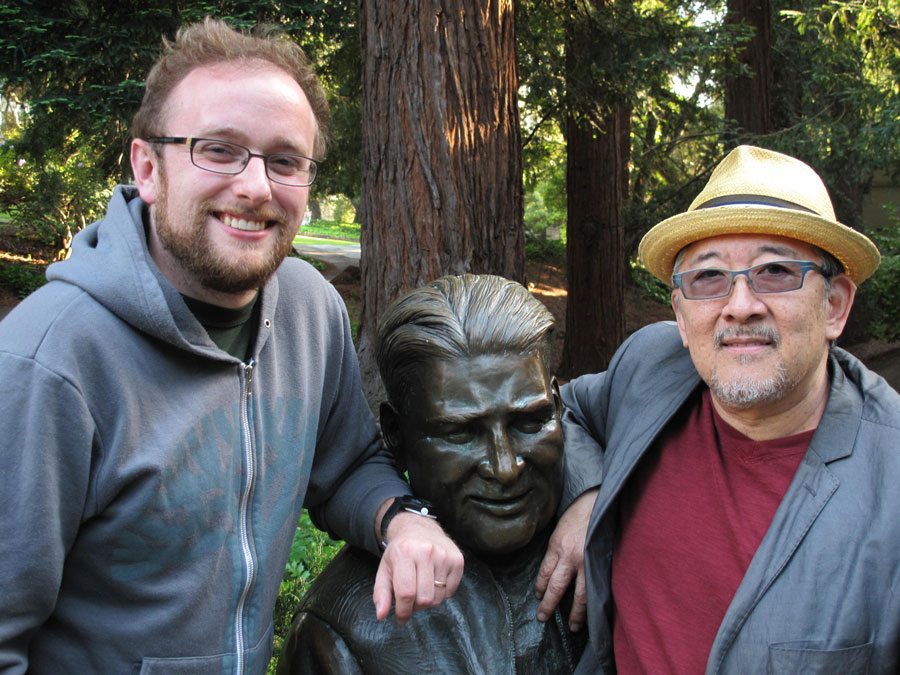
Instructors
Philip Kan Gotanda: Over the last three decades, playwright Philip Kan Gotanda has been a major influence in the broadening of our definition of theater in America. Through his plays and advocacy, Gotanda has been instrumental in bringing stories of Asians in the United States to mainstream American theater as well as to Europe and Asia.
Joshua Williams: A graduate student in the Department of Theater, Dance and Performance Studies, Joshua is a teacher, writer, actor/director and scholar of theater and performance in Africa, postcolonial theory, and the Cold War.
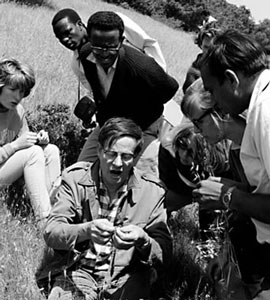
Notice the man at the back of the group, leaning to our left? Can you imagine what he’s thinking about?
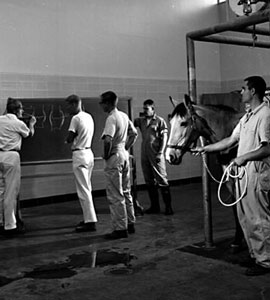
What do you make of the horse? Of course, the three men in the photograph are worthy of our attention as well. But for our purposes consider Mr. (or Ms.) Horse. What’s the story there?

What about this woman? What’s running through her mind? Do you think she told people later about being photographed by Ansel Adams? What do you think she said?
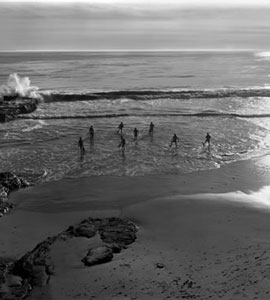
Photographs capture a moment in time, but we can always speculate as to what might have happened just before the shutter clicked, or immediately afterwards. Imagine, if you will: moments after this photograph is taken, a flying saucer breaks the surface of the water and shoots straight up into the sky. The scuba divers are in shock, unsure how to respond. What do you think would happen next?
Words, Images, and Access
“Words, Images and Access” is an invitation to describe one or more of the Fiat Lux photographs and other images on this site.
What exactly is this “same page” we all are or should be on? How can a blind student or professor or staff member be “on the same page” in a project that involves viewing, one that in fact that requires seeing photographs?
The two of us are involved in an ongoing project with a group of scholars from across the University of California and elsewhere, exploring the possibilities and problems of audio and textual descriptions of images for blind and visually impaired readers. In that project, we are critiquing examples of audio and textual description as it is currently practiced, examining their aesthetic, ideological, political and ethical underpinnings.
We invite you to join us in exploring the interesting questions raised–about access, about our assumptions about blindness and photography, and about the pleasures and pitfalls of description itself–as together we take up the project of describing in words what is going on in the pictures in Fiat Lux. Our goal is to develop verbal descriptions of every photograph in the book and on this site in order to increase the range of people’s access to them, as well as to develop more complex understandings of the acts and implications of describing.
Any describer of any image has to make many choices about how much and what kind of information to include. These choices will inevitably be based in attitudes and assumptions about the people who are being described for. And even when they aim for objectivity and neutrality, descriptions will always come from their own interpretative frameworks, which may be at odds with artists’–here, for instance, Ansel Adams’ –intent.
Join us as a describer. Pick a photograph and play with description, following our suggestions in the sidebar.
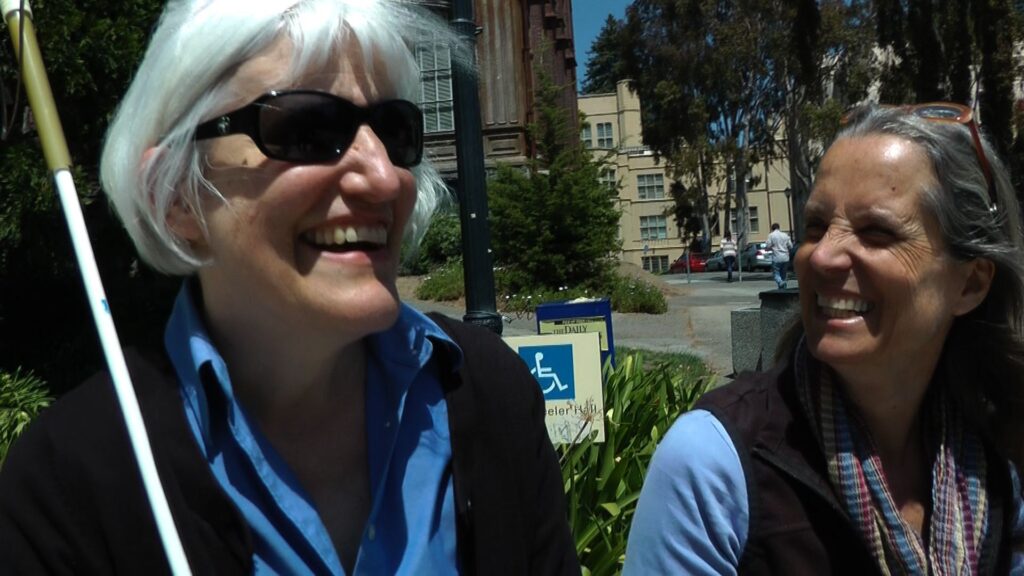
Prompt
This is a good project to do in a group of 3-4 people:
- Choose a photograph from our Fiat Lux Image Remix Site
- Each member of the group should write down 3-4 nouns naming the objects, people and spaces in the photograph.
- Now, write down three adjectives that come to mind when you look at the image. The adjectives could describe the expressions on the people’s faces, the overall mood the image evokes, or the emotion you think the image is supposed to elicit from you.
- Compare your lists with the other members of your group. Point to the specific elements in the photograph that made you choose the words you did. Are there nouns and adjectives that recur in everyone’s lists? Where do you disagree? Are there other words you could use that would be more accurate?
- As a group, write 1-2 sentences describing the image. Be sure to include objective information naming the people, objects and spaces in the image, as well as subjective responses about the overall mood or emotional content of the image.
- Test your description. Find some other photographs with similar content. Ask someone outside your group to look at these images and pick the one that matches your description.
- Email a Word file that contains a copy of the photograph and your description, along with the official caption from the dispensary. Also include the names and emails for your collaborators on the project. Mail to fiatdescription@gmail.com.
Contributions will be incorporated into a database that makes the Fiat Lux collection accessible to everyone through description, and there will be a contest for the best descriptions!
Instructors
Georgina Kleege teaches creative writing and disability studies in the English Department. She co-directs the Disability Studies minor.
Susan Schweik is a Professor of English and Associate Dean of Arts and Humanities. She co-directs the Disability Studies minor.
Perform The Score
Use the Ansel Adams photographs taken of outdoor spaces as inspiration to perform investigative and impromptu movement scores.
Locating outdoor photographs from the Fiat Lux archive taken on the UC Berkeley campus, students enrolled in Lisa Wymore’s Sophomore Seminar, Theater 84, will inhabit selected sites depicted in the Adams’ photographs. They will then engage with the outdoor sites using movement inspired explorations to create an improvisational score for the greater student body, and the public, to perform on a specific date and time. This process will be repeated over a seven-week period in the fall term.
Other students (not enrolled in the seminar) will be invited to “perform the score” by participating in the flash-mob-like events described in the prompt.

Prompt
Prompts will be posted to this site and announced on facebook and twitter starting on September 6th. Follow us on facebook or twitter (links in the circles at the bottom of this page) in order to stay informed about performance scores, specific locations, and dates/times to meet. Think of it as a kind of flash mob experience without the set choreography. Instead participants will be asked to arrive at a certain location, on a specific date and time, and perform an improvisational/experiential score with other participants. The event will be both an informal and seemingly impromptu performance and an investigation into the past and future of the given site – a site that has already been framed by Ansel Adams. Each performance experience will be photographed and documented anew, creating a layer to be placed onto the Adam’s photograph. The hope is that this layering will create a kind of portal from the future to the past, and will inspire students to engage with the On the Same Page program even further.
In the spring term of 2013, selected photographs and videos created in “Perform the Score” will be utilized in the Berkeley Dance Project – a fully produced dance concert presented by the Department of Theater, Dance, and Performance Studies.
Instructor
Lisa Wymore is the Director of the Dance Program within the Department of Theater, Dance, and Performance Studies at UC Berkeley. She has been working with dance improvisation since 1996 – using improvisation in live performances and within site-specific performances. She is the Co-Director of Smith/Wymore Disappearing Acts – an award winning dance theater performance group based in the Bay Area smithwymore.org.
Excavate The Future
Re-photography and staging of Ansel Adams photographs of Berkeley and beyond.
We are interested in looking at the photographs taken by Ansel Adams of the Berkeley campus (and possibly further afield) and doing re-photography of these same photographs to compare, rethink and recontextualize the choices and conditions of the late 1960’s with our present and forecast future. In anticipation of working with the Fiat Lux On the Same Page program, we’ve already experimented with GigaPan technology to re-stage the Cal marching band shot taken on Sproul Plaza. The final composite image is comprised of hundreds of photographs in an attempt to recreate the resolution and feel of Adams’ camera. But rephotography can be achieved with 35 mm DSLR or an iPhone camera, with some practice and guidance. The challenge is to be able to get the exact point of view taken by the original photographer.
Once the photograph is taken, Adams’ photograph can be layered on top of or below the new photograph in Photoshop or other image software. Sergey Larenkov, a master of computational rephotography, uses masking effects so that parts of the earlier historic image penetrate, or intrude onto the new photograph. The nature of the masking depends on the story being told through the layering of past and present. This technique can produce evocative re-compositions that are multi-perspective and invite the viewer to think beyond either the ‘old’ or ‘new’ frame.

Prompt
We will be holding workshops to demonstrate the two parts of this prompt: 1) Select one of Adams’ photographs of the campus. Search out the point of view of Adams when he took the photograph. With DSLR, point-and-shoot, or smartphone camera, create your photo. 2) Using Adobe Photoshop (part of the free suite of software available to all students) create a layered image using the original Adams photo and your new photo, using masking and filtering to represent a message that you wish to express through this rephotograph. Your finished product should include metadata that comprises technical details of what you did, but also what was the message you were hoping to convey with the rephotograph. In our workshops, we will cover all of the steps necessary to successfully produce a rephotography experience. The same Adams photograph can be rephotographed by different students in order to convey very different messages.
Instructors
Ruth Tringham is an archaeologist who just retired as a Professor of Anthropology at UC Berkeley, Berkeley and is currently the creative director and president of the new Center for Digital Archaeology [CoDA]. Her research focuses on the life-histories of people, places and things and the multisensorial construction of place in Turkey and Southeast Europe.
Michael Ashley is Chief Technology Officer for CoDA, where he leads its technical development activities, formulating vision and long-term strategies, and establishes partnerships and alliances with on and off campus organizations. True Blue, he received his PhD in 2004 and his BA in 1994, both at Cal in Anthropology, and has been collaborating with Prof Tringham ever since he was an undergraduate.
The Center for Digital Archaeology (CoDA): a 501(c)3 California Not-For-Profit Corporation at the University of California, Berkeley, drives the adoption and development of innovative digital heritage solutions, emphasizing the practical, the doable, and the achievable with as little reliance on technology specialists as possible.
Invent the Future
A Fall class designed to help cultivate Fiat Lux Remix creative projects and to imagine the future of the University of California.
This class provides space for face-to-face engagement with the Fiat Lux photographs, their remixed variations created by students, and the re-invention of the university itself. You are invited to enroll and participate!
FIAT LUNCH: Curatorial and Social Practices and the University of California Ansel Adams Archive
PRACTICE OF ART 142 (course control #04407)
WF 12-3P, 494 Wurster, 4 units
Amanda Eicher, instructor with special guest Clark Kellogg
This class will track and initiate new works in performance, social practice, and curatorial/installation practice by students, faculty, staff, and community members working with material from the Fiat Lux archive. Through hands-on research, outreach, collaboration, experimentation, and project management (as well as weekly open lunches in the classroom), the course will engage artists, community members, and experts to construct a set of visions for the coming 50 years of the University of California in the form of an interactive, multidisciplinary exhibition and accompanying public programming. We will begin with an installation of existing artist interventions housed in the Making UC Futures Innovation Lab (the classroom for the course) at the start of the semester and work towards a Spring exhibition of commissioned artworks in the Worth-Ryder Art Gallery in Kroeber Hall. People can participate in this class either by enrolling, or by attending some of the open lunch sessions on Fridays. For more information contact Amanda Eicher: fiatlunch (at) gmail.com.
Instructors
Amanda Eicher holds an MFA from UC Berkeley’s Art Practice department and is a member of the artist collectives OPENrestaurant and The Citizens Laboratory. Students in her classes explore collaboration, project development, and creative problem-solving as they examine human relationships as an art medium for socially-relevant projects and programs.
Clark Kellogg trained as an architect and teaches in Berkeley’s Haas School Business and the iSchool classes designed to help students invent the future. Clark ignites people’s imagination, gives them tools with which to make things, and imparts a set of values to help people decide what future they want.

Fiat Lux Redux Contest
Announcing the final winners of the Fiat Lux Remix contest!
Our panel of faculty judges has chosen the following winners.
The Grand Prize
Luis Flores and Elena Kempf were both chosen to receive Grand Prizes ($500 gift cards).
Luis’s winning entry is his essay, The American University and the Establishment of Neoliberal Hegemony. In the words of one of our judges, this essay is “A nuanced and impressively argued research paper that includes both primary and secondary research. The author grapples in a sophisticated way with the unique role of the University of California, its historic charge and endemic weaknesses, especially is vulnerabilities and “habits” that came to the fore during Clark Kerr’s presidency and have continued to plague us in notable ways in the present.”
Elena, whose photo “Generations” won the September semi-finalist prize, receives her Grand Prize for the photo “Fight for Public Education.” As one judge expressed it, “The foreground and framing of this picture brings into view what is so notably absent from the Fiat Lux photos: the voice of dissent. The image suggests the megaphone both as a source of projection and sustenance. The protester in the foreground is as much an icon of Berkeley as is Sather Tower in the background. And yet, the institution itself is deeply conflicted about the former. What is the conversation between these two images of Berkeley?” Another judge noted that all three of the photographs Elena submitted are stunning.
Elena and Luis, along with the Honorable Mention winners listed below, will also meet with the Chancellor, UC President, and Regents to present their winning entries and their visions for the future. We are proud to be represented by such talented and brilliant students.
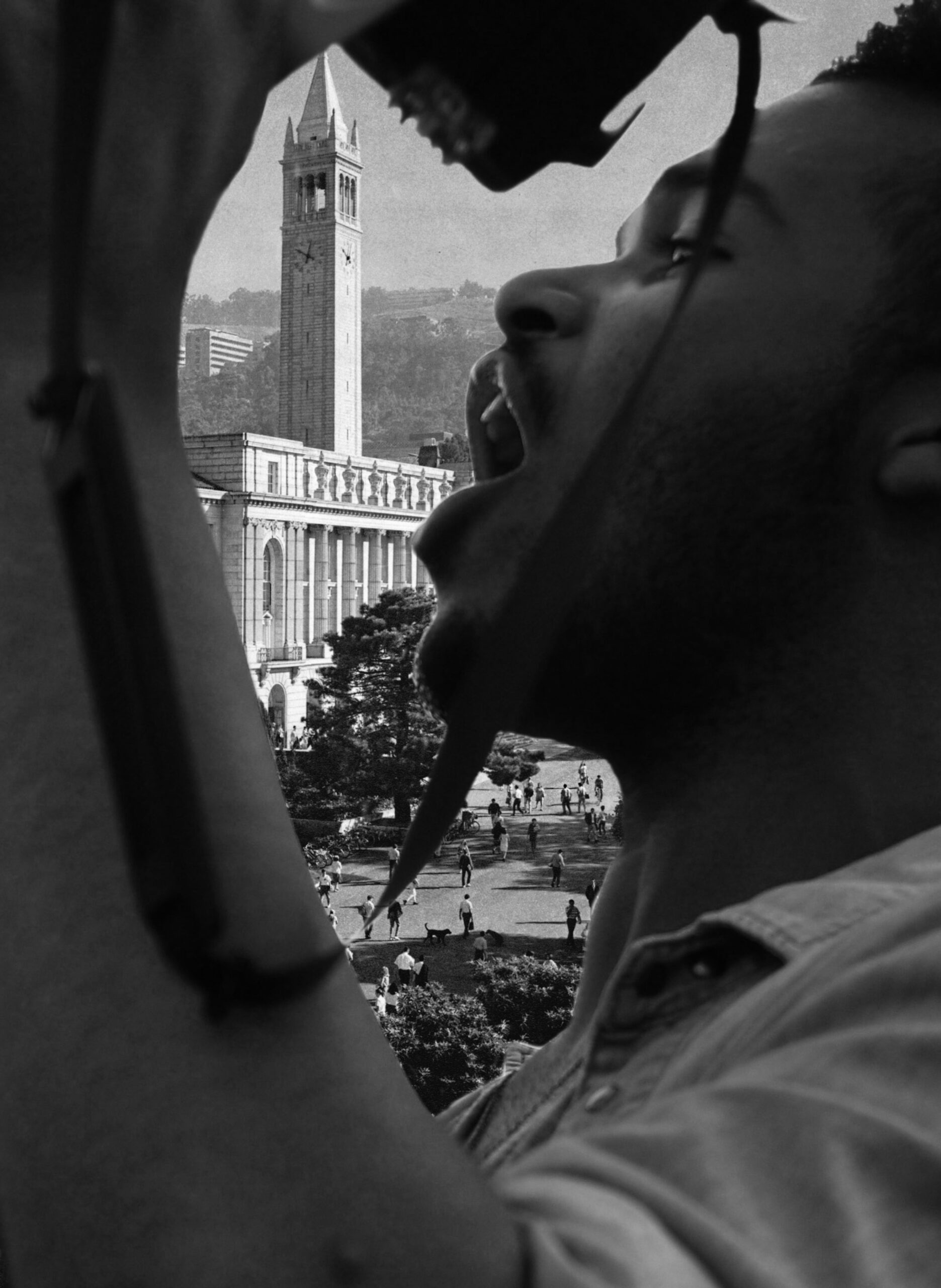
Honorable Mention
Five submissions were chosen for the Honorable Mention prizes and $200 gift cards:
Pauline Autet, for her booklet A Call to Care. Those who would like a copy of her thought-provoking and attractive booklet can pick one up at the Fiat Lux, Fiat Lunch, Fiat Futures exhibit, starting February 13, 2013.
Yuan Chen, whose acrylic painting “The Lettuce Picker” brilliantly recreates one segment of an Ansel Adams photograph.
Everto Gutierrez, for his photograph “Field Day”, which evokes Adams’ photo of a field trip in a nuanced way.
Joseph Mann, whose photoshopped image “Rephotography at the Big C” is, according to one of the judges, “A visually compelling image that subtly makes an interesting argument about race.”
Sheila Wagner, whose image “Fiat Lux” is, one judge’s words, “A haunting image that is powerful in its sheer visuality, and beautifully layered and assembled.”
All of the winning entries will be on display at the Fiat Lux, Fiat Lunch, Fiat Futures exhibit from February 13 through 23.
Press Coverage
Fiat Lux Remix project allows students to imagine UC’s future
BY HAILEY SIMPSON, Daily Cal Staff | April 18, 2013
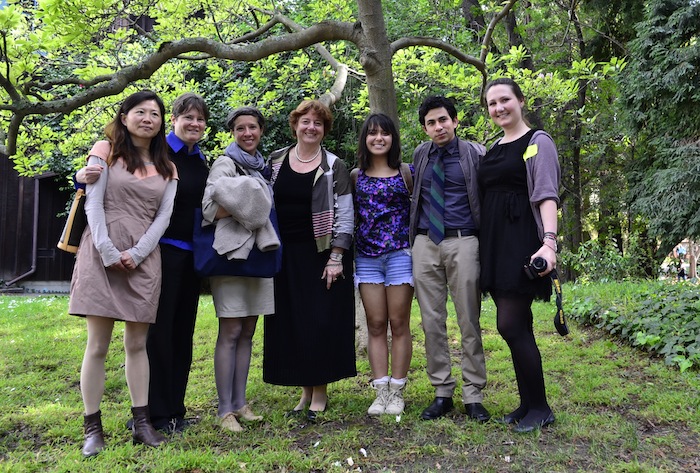
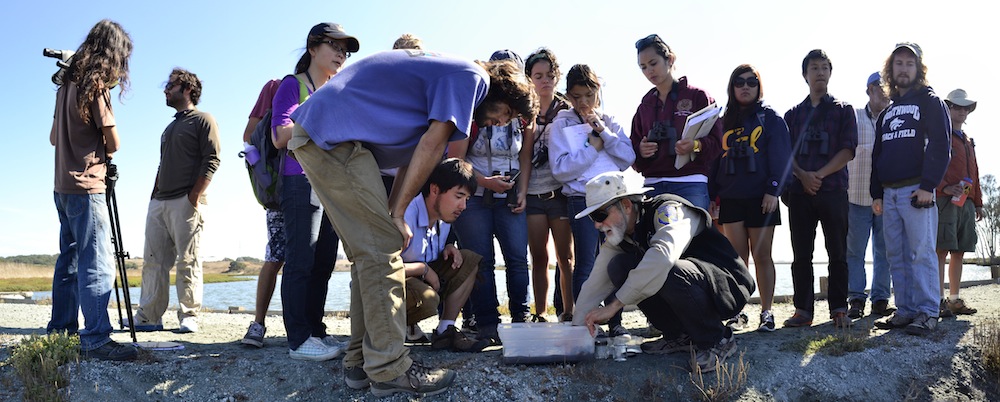
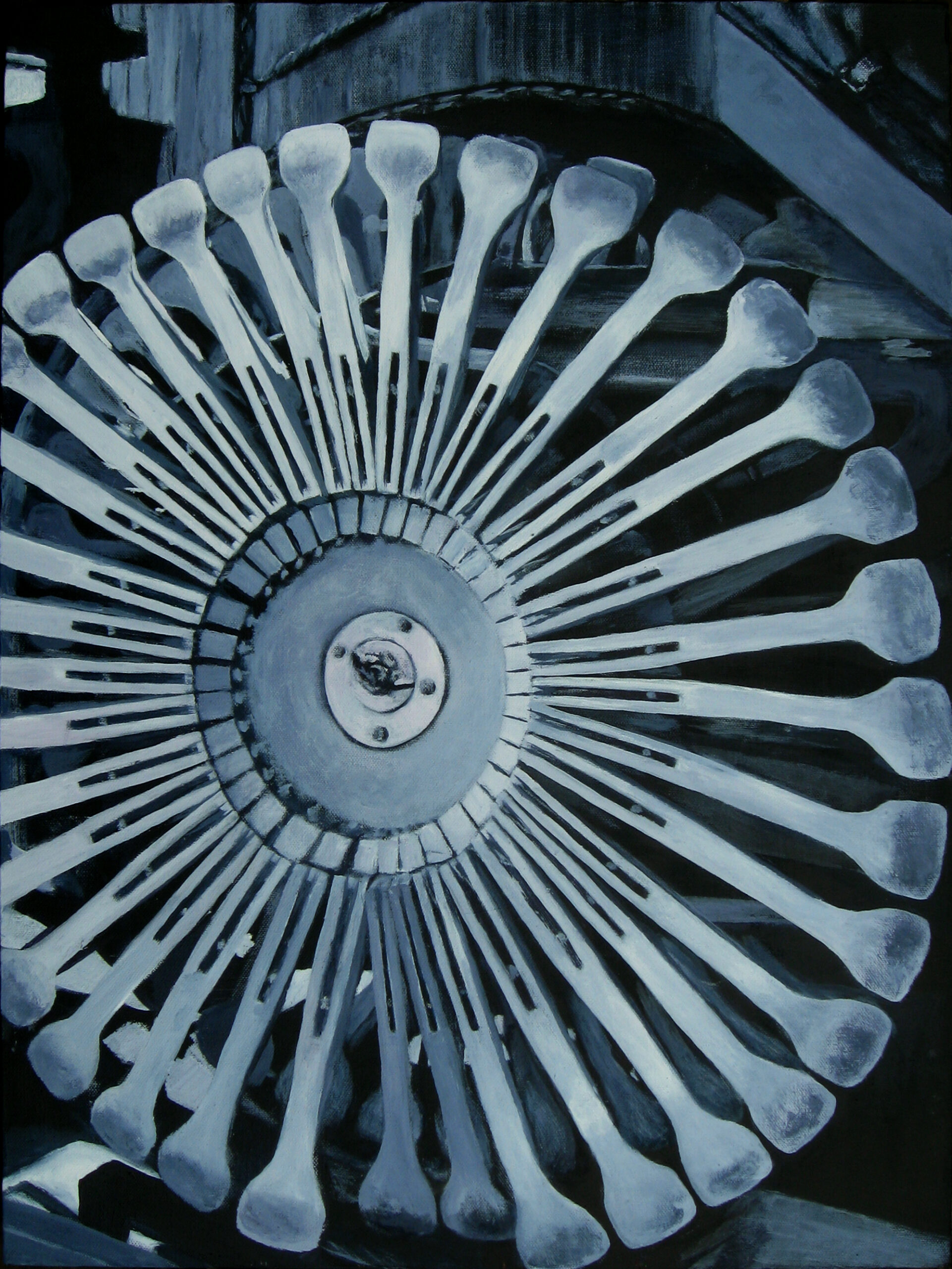
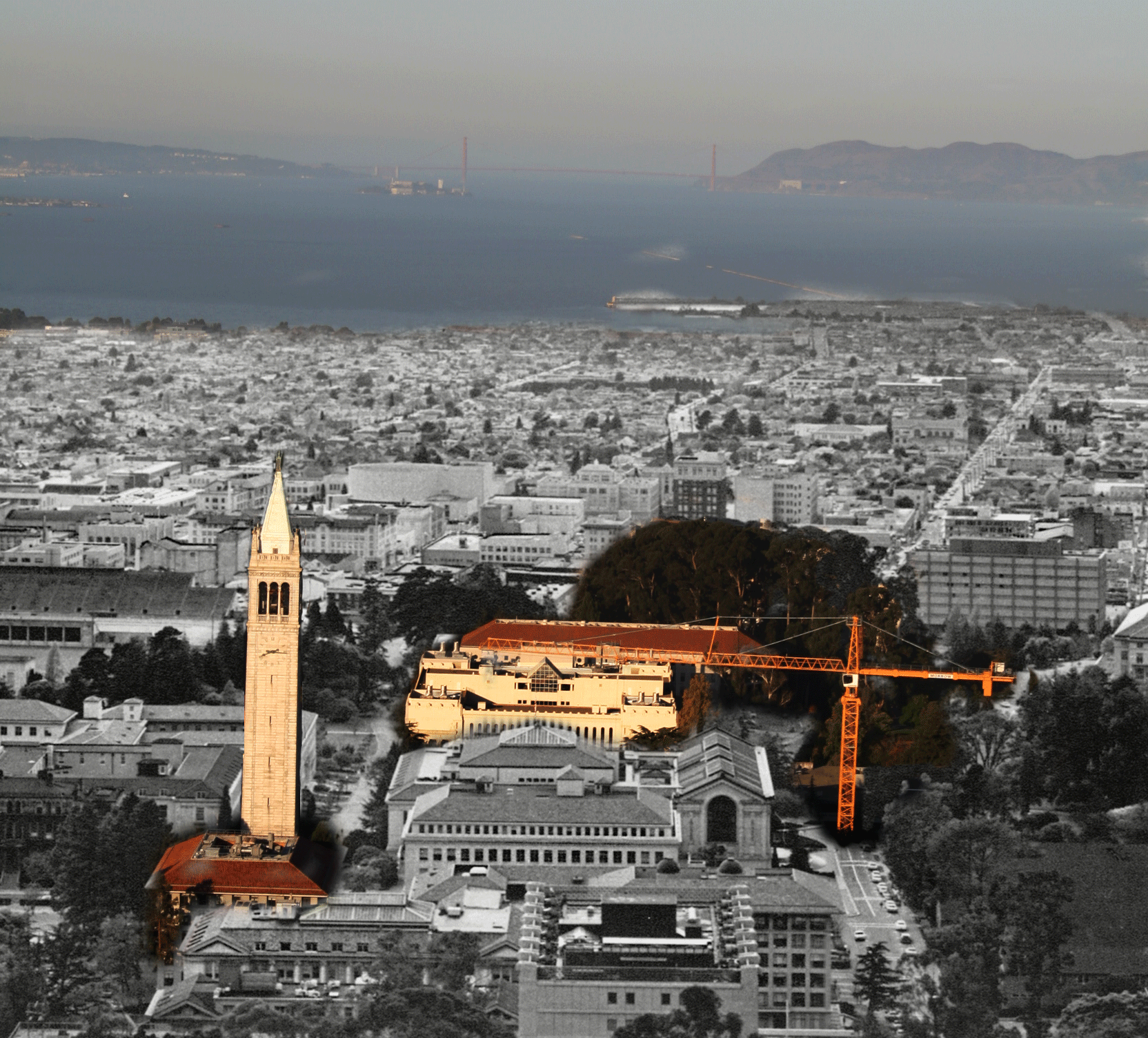
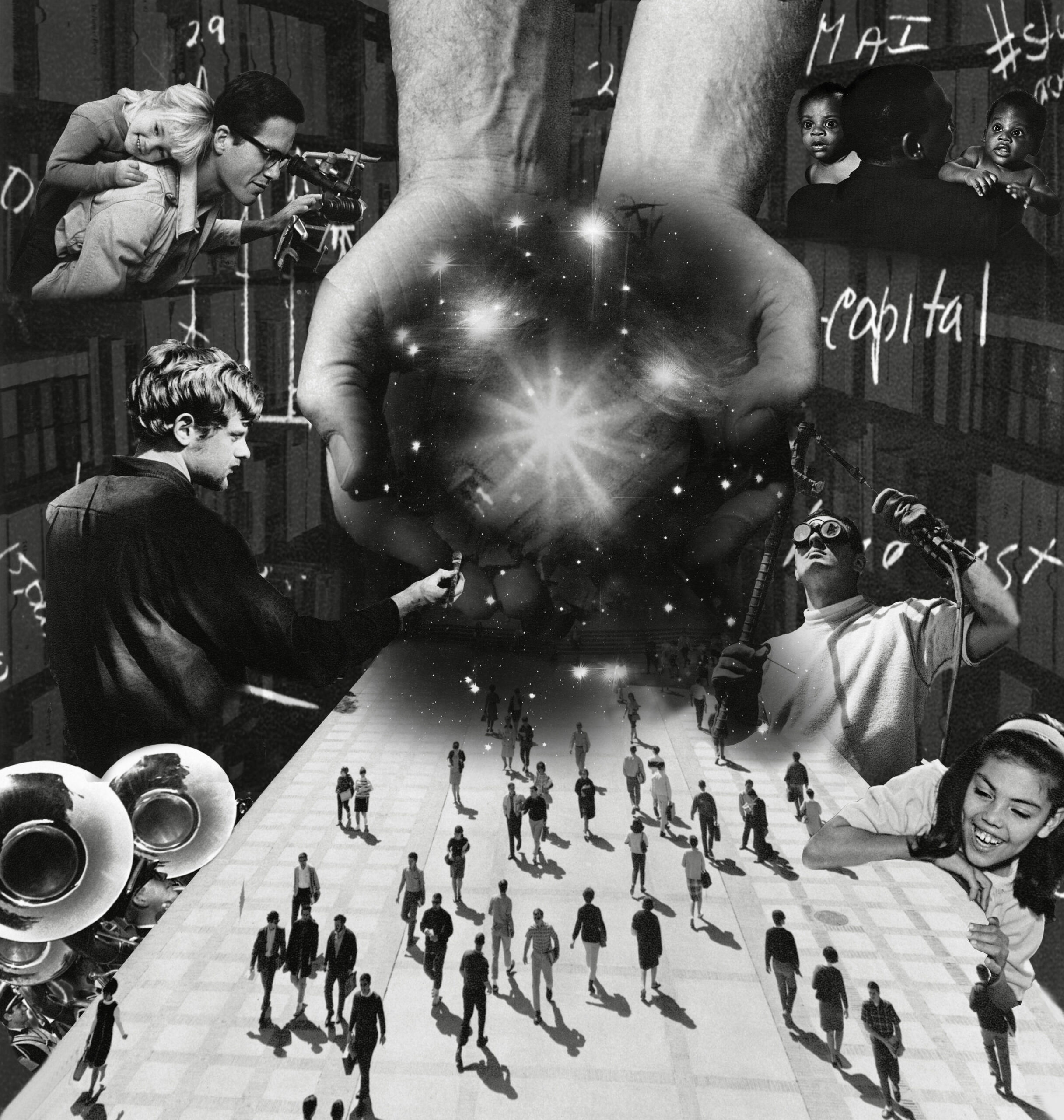
Fiat Lux Redux Contest: November Winners and People’s Choice Award
Our panel of faculty judges has selected two winners for November’s Fiat Lux Remix contest: Pauline Autet and Daniel Hogan.
Pauline’s piece is a booklet, A Call to Care, that combines photos by both Ansel Adams and Autet herself with history and critical analysis. She is raising funds to print copies to distribute at the Fiat Lux, Fiat Lunch, Fiat Futures exhibit in February.
Daniel’s photo-essay, Physics Landscapes, illustrates facets of physics research at UC Berkeley and Lawrence Berkeley Lab, in an effort to fill in some of the blanks left by Adams’ depiction of science at the university.
Pauline and Daniel have each received a $150 gift card to the Cal Student Store. Congratulations to Pauline and Daniel!
The People’s Choice award, determined by number of “likes” on Facebook, goes to Joon Suk (Terrence) Park, Sa-Nan (Emily) Park, and Sa-Heen (Carrie) Park, who photographed the campus at various times across a 24-hour period and combined the photos into one collage. Their artwork received thirty-three “likes” on Facebook.
All of these pieces will be in the running for the Grand Prizes to be awarded in February. The prizes include the chance to meet with the Chancellor, UC President, and Regents.
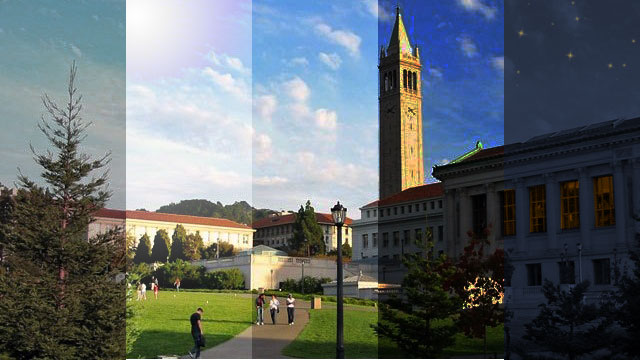
Our panel of faculty judges has selected two winners for October in our Fiat Lux Redux Contest
First prize goes to Everto Gutierrez, for his photo “Field Day,” which evokes Ansel Adams’ Professor Stebbins Field Trip images in a complicated way. Everto has won a $150 gift card to the Cal Student Store.
Second prize has been awarded to Yuan Chen, whose beautiful oil painting, “Arches,” renders a segment of Adams’ photo of the Arches of the Humanities Building at UC Riverside. Yuan Chen has won a $100 gift card to the Cal Student Store.
Both of these pieces will be in the running for the Grand Prize to be awarded at the end of the year.
On the Same Page thanks everyone who has submitted artwork to our contest, and encourages everyone else in the campus community to submit your vision for our future, whatever form or format that may take. We will accept photos, essays, stories, plays, films, manifestos–you name it. We will choose additional monthly winners in November, and the Grand Prizes in December. Entries received by December 7 will be considered for prizes, and the chance to meet with the Chancellor, UC President, and Regents.
Congratulations, Everto Gutierrez and Yuan Chen!
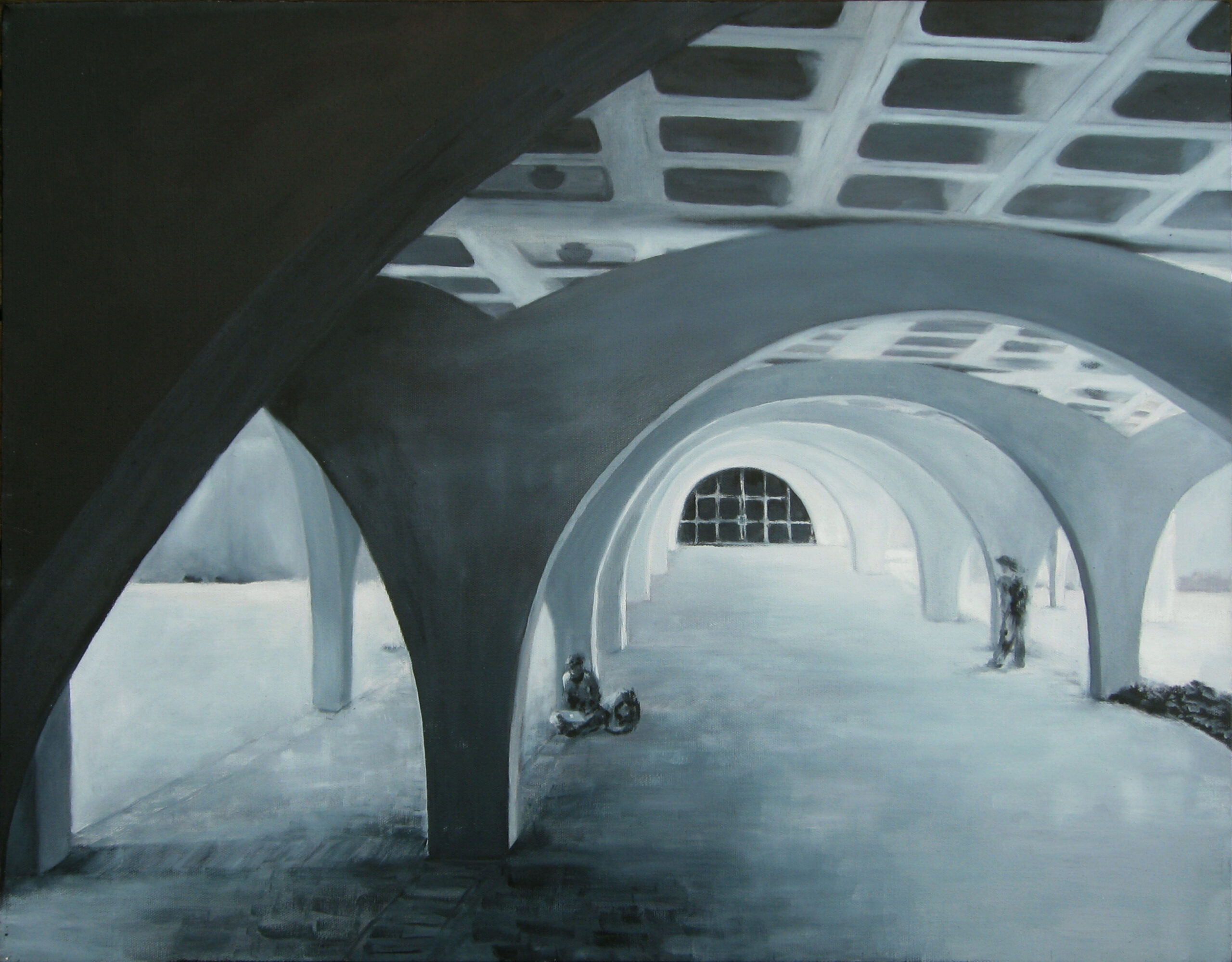
Elena Kempf is our First Fiat Lux Remix Winner
Our panel of faculty judges has selected Elena Kempf’s photo remix, “Generations,” as the September winner of the Fiat Lux Remix contest. As Elena described it, “The idea behind this remix is the importance of long-term thinking and caring about the prospects of generations to come.”
Elena has won a $150 gift card to the Cal Student Store, and her entry will be among those in the running for the Grand Prize in December.
On the Same Page thanks everyone who has submitted artwork to our contest, and encourages everyone else in the campus community to submit your vision for our future, whatever form or format that may take. We will accept photos, essays, stories, plays, films, manifestos–you name it. We will choose additional monthly winners in October and November, and the Grand Prizes in December. Entries received by December 7 will be considered for prizes, and the chance to meet with the Chancellor, UC President, and Regents.
The “People’s Choice” award will be determined by the number of facebook “likes” that each posted project receives by December 7.
Congratulations, Elena!
News and Articles
Fiat Lux Remix project allows students to imagine UC’s future
BY HAILEY SIMPSON, Daily Cal Staff | April 18, 2013
Contest winners shine new light on Fiat Lux
By Steve Hockensmith, Berkeley News | APRIL 9, 2013
Fiat Lux Again: The University’s take on Ansel Adams’s take on the University
By Kenneth Brower, California Magazine | Winter 2012
Fiat Lux Redux: A look back at University of California history
October 9, 2012, link: UCOP’s e-newsletter
‘Fiat Lux’ asks us, again, to picture UC’s future
By Barry Bergman, Berkeley News | SEPTEMBER 25, 2012
Ansel Adams’ photography collection aims to capture incoming students’ attention
BY DYLAN TOKAR, Daily Cal Staff | June 5, 2012
Ansel Adams UC photos reissued for Berkeley campus
By Matt Krupnick, Contra Costa Times | Posted: 06/04/2012
Ansel Adams: Picturing California’s Future
Ken Goldberg, SF Gate Article | June 1, 2012
Picturing Our Future
Catherine M. Cole, Townsend Center Newsletter | FEB 2012
Picturing UC’s future
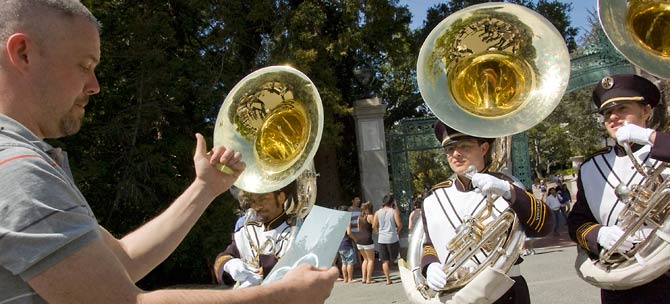 At a precise location near Sather Gate, members of the Cal Band gamely shouldered their instruments Monday for a technically demanding photo op. The goal: to recreate a shot taken close to half a century ago by photographer Ansel Adams — this time for a 21st-century campus project on “picturing” UC’s future.
At a precise location near Sather Gate, members of the Cal Band gamely shouldered their instruments Monday for a technically demanding photo op. The goal: to recreate a shot taken close to half a century ago by photographer Ansel Adams — this time for a 21st-century campus project on “picturing” UC’s future.
Among the faculty consultants on hand were Michael Ashley and Ruth Tringham of the Center for Digital Archaeology. Choreographer Lisa Wymore helped position students for the shot, which used digital gigapan technology to recreate the composition Adams achieved with his 4×5 view camera.
The recreated photograph of student musicians with their gleaming sousaphones — Sather Gate and Tower in the background — will be used to design a poster for the College of Letters and Science’s signature “On the Same Page” program. Its 2012 topic: “Fiat Lux,” a portrait of UC commissioned by the regents and created by Ansel Adams and writer Nancy Newhall between 1963 and 1967.
Adams’ Fiat Lux photos evoke many and varied feelings about UC — pride and nostalgia being just two, said Catherine Cole, a professor of theater, dance and performance studies, at the reshoot. (Read her essay on the Fiat Lux series, “Picturing Our Future,” here.) This year’s project, she said, is intended “to give the students a bit of their history,” and “an opportunity to rethink UC” at a critical juncture in its evolution.
Monday’s photo will also be used to create a banner and/or poster for “Fiat Lux Redux,” a Bancroft Library exhibit this fall showcasing images from Adams and Newhall’s four-year project. The Bancroft holds more than 600 signed “Fiat Lux” photos of the UC system — its campuses, labs, field stations, even educational field trips; a total of about 6,700 negatives reside at UC Riverside.
Through “On the Same Page,” students will be invited to engage with the Fiat Lux collection in various creative ways, Cole said — “to look critically at them,” asking “‘what do we want to preserve?’ and ‘what to reinvent’ about UC.” Digital-art remixes and essays on a group of the photos are just two of the ways they’ll be invited to participate.
2012-13 Events
“Aperture” \ Berkeley Dance Project 2013
Thursday, April 18, 2013 to Sunday, April 28, 2013
Zellerbach Playhouse
From 1964-68, Famed photographer Ansel Adams spent time at the University of California on a groundbreaking photographic project commissioned by UC President Clark Kerr. At its core the project, entitled Fiat Lux (Let There Be Light, the University of California motto) asked Adams to answer the question “How can we imagine our future?” Over the course of the project, Adams took thousands of photos of the entire UC system, culminating in a published book written by Nancy Newhall in 1967, which was revisited in a full-year, campuswide multimedia exploration of Adams’ work this year called On the Same Page.
Berkeley Dance Project 2013: Aperture, the final production in UC Berkeley’s Department of Theater, Dance, and Performance Studies Main Stage season, responds to and continues Adams’ work as part of the On the Same Page initiative, featuring four choreographic premieres and an exhibition of student artistic work , each bringing new perspectives and framings of contemporary life. The production opens April 19 in Zellerbach Playhouse.
Lisa Wymore’s piece, titled We all need light: stories from the grove, investigates real life stories of students living and working on the UC Berkeley campus today. These stories are layered with images from the 1964-68 Adams/Newhall Fiat Lux project, and with video images made by Iranian artist and UC Berkeley Art Practice Visiting Lecturer Azin Seraj. Out of Adams’ thousands of photos, students have chosen some of the few Adams took of “natural” settings on the UC Berkeley campus: a eucalyptus grove which the students were drawn to as a quasi-bucolic setting within which they could explore movement. Wymore and her collaborators, Seraj, the students, and composer Ben Juodvalkis, have worked together to create a highly kinetic dance piece that reveals intimate and personal moments of being a student, and a human being, within an institution of higher learning.
Choreographer Katie Faulkner’s piece, titled Animal Eulogy, illuminates the absurd, poetic, futile, and heroic efforts we make to derive comfort and meaning within our capricious and uncontrollable universe. Employing spare yet surreal visual states that evoke imagery of Hurricane Katrina, surveillance satellites, and Charles & Ray Eames’ iconic film Powers of Ten, this work seeks to capture the unfathomable juxtaposition between our small, intimate lives and the ever-magnifying power and scale of the natural world.
In Fiat Luv, Choreographer Scott Wells’ playful choreography displays his inventive dynamic partnering with some surprising live music elements which together create an evocative performance around the theme of finding partnership in a complex world. Working with the strengths of the student performers, Wells has crafted a funny, energetic, and moving work. Fiat Luv is inspired by the collegiate experience contextualized within the Fiat Lux campus project, yet it reaches beyond the boundaries of student life to ask a timeless question, “Why do we dance?” Do we dance to make high art and search for life’s meaning or do we dance to reenact the performance of mating rituals? Perhaps both – let there be light, love, and…
What happens when punctuation meets choreography? How do we orchestrate the flows of our movement and our language? TDPS graduate student Chia-Yi Seetoo’s piece continues her ongoing interest in exploring the fractures, tensions, and sometimes fantastic bursts of “culture” and “identity” that occur as we move throughout our contemporary existance. Seetoo and her unique ensemble of UC Berkeley dancers dwell on the breaks, the differences, the specificities, and the idiosyncrasies of personal movement and speech. The choreography punctuates these movement explorations seeking to bring to light the multiplicities found withinin one’s self, and within the collective.
Exposure:Exibit (Designed to be viewed in conjunction with the Berkley Dance Project) shares some of the visual art projects created by students in response to Fiat Lux including current images of the Berkeley campus taken by students in the Art and Science of Digital Photography course taught by Computer Science Professor Brian A. Barsky. Other work has been created by students from the Art Practice New Genres course Fiat Lunch, taught by Amanda Eicher, as well as students from across campus participating in an On the Same Page contest. Exposures, installed in the lobby of the Zellerbach Playhouse, will be viewable before and after each performance.
TICKETS AND INFORMATION
Berkeley Dance Project 2013 opens on Friday, April 19 at the Zellerbach Playhouse on the UC Berkeley campus (at Spieker Plaza across from the Haas Pavilion) and runs on weekends through Sunday, April 28.
Presented Fridays & Saturdays at 8pm, Sundays at 2pm
April 19, 20, 26, 27 – 8pm
April 21, 28 – 2pm
Tickets required: $10.00 Students, Seniors, UC Faculty/Staff, and $15.00 General Admission
Tickets can be purchased by phone (510-642-8827) or in person at the Zellerbach Playhouse box office on Fridays from 1pm to 4pm. The box office also opens one hour prior to each performance for will call and ticket sales for that day’s performance.
Exposures exhibit hours:
1 hour before each BDP show
April 26th: Special Hours 4pm to 7pm (free, no ticket required)
Fiat Lux, Fiat Lunch, Fiat Futures (Multiple Events)
February 13-23, 2013
Ansel Adams and Nancy Newhall’s “Fiat Lux” envisioned a future vision for the UC system, one which students will investigate and update for ten days in February at the Worth Ryder Art Gallery. The gallery will activate as a laboratory for exhibiting and strengthening a student-driven vision for the future of the University, developed over the fall of 2012 and curated by Art Practice/New Genres 142: Fiat Lunch. This undergraduate course was supported by On The Same Page, a University-wide initiative which in 2012 took the 1967 publication as a starting point for classes, seminars, events, and research investigating the University’s past, present, and future.
Fiat Lux, Fiat Lunch, Fiat Futures will include work from the Fiat Lunch class and other courses addressing the future of the University, as well as the winners of the On The Same Page Remix contest in which participants engaged the Fiat Lux archive of images to create new works contributing to the conversation around UC Futures. The exhibition, which includes video documentary, policy proposals, research documents, interactive media works, installation, painting, and sculpture, will also feature a movie screening and opening night party, a panel discussion and workshop, and a reading of Josh Williams’ play “In the House We Haven’t Built,” an interpretation of the Fiat Lux archive for stage.
Reception | Wednesday February 13, 4-8PM
Public Programs
“In the House We Haven’t Built,” Reading of play by Josh Williams | Thursday, February 14, 4-6PM
Cupcake social, Bancroft and Kroeber Plazas | Friday, February 15, 11AM-2PM
“Collaborative Institutional Design,” panel discussion, film screening, and workshop | Wednesday, February 20, 4-6PM
“Berkeley Dance Project: Performing the Score,” social performance by TDPS students | Thursday, February 21, 1-3PM
“Fiat Lunch: An Open Lunch Laboratory,” social performance by Art Practice students | Friday, February 22, 12-2PM
Round Table Discussion on Fiat Lux by Ansel Adams and Nancy Newhall
Thursday, November 15, 2012 – 17:00 – 18:30
Wurster 112
A College of Environmental Design discussion on the past and future visions of UC Berkeley with Sam Davis, Janet Delaney, Kristina Hill, Malo Hutson, Ananya Roy, moderator, Andy Shanken and Fiat Lux photo montage by Jason Miller.
Exhibit of Paintings by students in Art Practice 102: Approaches to Painting
Wednesday, November 7, 2012 to Wednesday, November 21, 2012
Third-floor atrium in Kroeber Hall
Taught by Katherine Sherwood
Adams was always very attentive to a full range of tonal values in each of his photographs. Sherwood’s students created paintings based on segments of Adams’ Fiat Lux photos.
Art Practice 102: Approaches to Painting
READING OF NEW PLAY INSPIRED BY FIAT LUX
Thursday, October 18, 2012, 5:00 pm
Durham Studio Theater, Dwinelle Hall
Since last Spring, Joshua Williams, a doctoral student in Performance Studies, has been working on his new play, IN THE HOUSE WE HAVEN’T BUILT. The play will receive its first public reading this Thursday, October 18th.
Williams’s interest in the Fiat Lux/Ansel Adams archive was piqued by conversations with Catherine Cole — the lead curator of the exhibit on Adams, Newhall and Kerr that is currently on view in the Bancroft Library. Newhall and Adams dedicated the original Fiat Lux spread book “to those who will make the future,” and Williams’s play follows in that line by drawing the past, present and future of the University of California into a poignant collage. IN THE HOUSE WE HAVEN’T BUILT features four actors playing dozens of roles, including Adams, Newhall, Kerr, Reagan, Savio and many others. Just as in Adams’s haunting, proleptic photographs, the past haunts the future in this play as the contemporary story of a pair of Berkeley professors, a graduate student and a celebrated local poet returns again and again to the cultural divisions that broke the 1960s into pieces.
On Thursday, October 18th, at 5:00PM, Williams will present a free, public reading of some of the scenes from IN THE HOUSE WE HAVEN’T BUILT at Durham Studio Theater in Dwinelle Hall as part of the Department of Theater, Dance & Performance Studies’ New Play Reading Series. This reading, which will feature a number of talented student and alumni actors, marks the beginning of a process of public engagement with this nascent script. Williams plans to continue to develop the play in conversation with members of the University community, and he hopes to show the entire piece again in the Spring. Get in on the ground floor at Thursday’s reading and help to develop one of the most ambitious engagements with Fiat Lux to date!
Images, Advocacy and the Public Good: The Adams/Newhall Collaboration Kenneth Brower and Wendy Brown
Wednesday, October 17, 2012 – 17:00 to 16:30
Maude Fife Room, 315 Wheeler Hall, UCB
Writer, environmentalist and editor of the Sierra Club Exhibit Format Series Kenneth Brower together with Berkeley political theorist Wendy Brown will talk about the Ansel Adams and Nancy Newhall collaboration on the Fiat Lux book about the University of California. They will be reflecting on selected images of the university as well as on ways these artists used photography to advocate for public goods. Co-sponsored by The Bancroft Library and the Making UC Futures Townsend Working Group.
Reception to follow.
Fiat Mashup! Appropriations and Creative Interventions Using Fiat Lux Photographs With Natalia Brizuela and Jeffrey Skoller
Thursday, October 11, 2012 – 17:00 to 16:30
Townsend Humanities Center, Geballe Room, 220 Stephens Hall, UCB
Fiat Lux images by Ansel Adams served as the creative inspiration for these videos made by UC graduate students that explore relationships between the past and the present in the transforming life and politics of UC Berkeley. This video screening and discussion with the filmmakers will be facilitated by Profs. Jeffrey Skoller, Dept. of Film & Media, and Natalia Brizuela, Dept. of Spanish and Portuguese. Co-sponsored by the Making UC Futures Townsend Working Group.
Reception to follow.
Perform the Score: Fiat Lux Redux
Thursday, October 11, 2012 – 14:00 – 14:30
At Eucalyptus Grove
Join the students of Theater 84 in a public movement score!
• Wear light colored clothes and sturdy shoes
• Come prepared to move and listen
• All abilities welcome
• All participants will be video taped as they move throughout the site
What is a movement score?
A movement score is a set of instructions that allow people to discover and explore within a given performance site. The score gives participants a way to move together and explore the resources of the site.
Why Fiat Lux?
Ansel Adams was commissioned in 1964 to create a portrait of the University of California during a period of spectacular growth and expansion. Perform the Score is a reconstruction of the original Ansel Adams photo taken of the Eucalyptus Grove on the Berkeley campus, which was part of this commission.
Take Five: Communicating a Vision through Multimedia Slide Shows
Tuesday, October 9, 2012
10:00 a.m. – 12:00 p.m. or
1:00 p.m. – 3:00 p.m
Location: Room 350C Moffitt Library (be sure to bring your Cal id for entrance)
Session Overview
In this hands-on session, participants explore how artists communicate point of view and vision through the selection, editing, and remixing of images from the Fiat Lux series by Ansel Adams. Then, participants work independently to create a multimedia slide show to communicate their “take” on a series of images related to a common theme.
Session Objectives
By the end of this session, participants will be able to:
- Define an artistic vision or point of view about a chosen theme
- Curate a series of photographs around a chosen theme using Adobe® Bridge®
- Edit a series of photographs to communicate an artistic vision or point of view using Adobe® Photoshop®
- Create a multimedia slideshow and publish to a variety of formats using Adobe® Photoshop®
This workshop will help participants become well positioned to be competitive in the Fiat Lux Remix contest.
Session Duration
2 hours
Note: All UC Berkeley students have access to Adobe Creative Suite 6 products which includes Adobe Photoshop, InDesign, Illustrator, and Bridge at no additional cost! Visit stc.berkeley.edu for download instructions and more information.
Workshops co-sponsored by Adobe and the Moffitt Library.
Artist’s Talk: David Huffman
Wednesday, October 3, 2012 – 15:00 – 14:30
Berkeley Art Museum
Join internationally recognized Oakland-based artist David Huffman for a discussion of his 2007 large-scale fantastical painting, Hunter Gatherer, on view in At the Edge: Recent Acquisitions. This fascinating work features a “traumanaut,” a character Huffman invented to combine the futuristic and exploratory dimension of the astronaut with the traumatic history of the African American people. Ansel Adams’ challenge, to “photograph the future,” is here attempted in a different artistic medium.
Designed for Cal students participating in On the Same Page. Gallery admission always free for Cal students.
Out of Frame: Past and Present Visions of the UC’s City of Intellect Chris Newfield & Seth Rosenfeld
Monday, October 1, 2012 – 17:00
Maude Fife Room, 315 Wheeler Hall, UCB
Through the Fiat Lux project, Ansel Adams pictured one of the most turbulent periods in UC history, the 1960s. Yet his photos give little evidence of tumult. The university appears as a pristine, calm, sparsely populated place. Seth Rosenfeld, author of the new book Subversives: The FBI’s War on Student Radicals, and Reagan’s Rise to Power, and Chris Newfield, author of Unmaking the Public University: The Forty-Year Assault on the Middle Class, will reflect on Adams’ framing of the “City of Intellect,” exploring what these images reveal, disguise, and foretell about the UC’s past and present. Co-sponsored by the Berkeley Faculty Association and the Making UC Futures Townsend Center Working Group.
Reception to follow.
EXHIBIT “Fiat Lux Redux: Ansel Adams and Clark Kerr”
Friday, September 28, 2012 – Thursday, February 28, 2013
The Bancroft Library Gallery, UCB
Featuring original prints by legendary photographer Ansel Adams, this is an exhibition of rarely seen images of the University of California System in the 1960s. The images—commissioned by former UC President Clark Kerr, and published in the 1967 book Fiat Lux which celebrated the educational system’s centennial—offer a unusual perspective on the evolution of the renowned University of California system through the eye of a master photographer best known for his iconic California landscapes. The exhibition also showcases related archival materials about the controversial Kerr himself, and the development of his ideas and ideals. The Fiat Lux Redux exhibit at the Bancroft Library will run from September 27, 2012 through February 28, 2013. The Bancroft Gallery open hours are 10:00 a.m. to 4:00 p.m. Monday through Friday. The Gallery will also be open October 7, for Homecoming weekend, from 10:00-3:00.
Exhibit Opening Reception: “Fiat Lux Redux: Ansel Adams and Clark Kerr”
Thursday, September 27, 2012 – 17:00 to 19:30
The Bancroft Library Gallery, UCB
Featuring original prints by legendary photographer Ansel Adams, this is an exhibition of rarely-seen images of the University of California System in the 1960s. The images—commissioned by former UC President Clark Kerr, and published in the 1967 book Fiat Lux which celebrated the educational system’s centennial—offer a rarely seen look at the evolution of the renowned University of California system through the eye of a master photographer best known for his iconic California landscapes. The exhibition also showcases related archival materials about the controversial Kerr himself, and the evolution of his ideas and ideals.
Fiat Lux through the Lens of Science and Technology
Wednesday, September 26, 2012 – 15:30 to 16:30
Maude Fife Room, 315 Wheeler, UCB
This interactive event will be moderated by Dean G. Steve Martin, and will feature the following panelists: Professors Fiona Doyle (Materials Science and Engineeering), Jasper Rine (Molecular and Cell Biology) and Philip Stark (Statistics). Each panelist will choose an Ansel Adams image from the Fiat Lux collection. The audience will first have a chance to discuss their own observations and inferences about the photos in groups, after which the panelists will share their own interpretations. This event is followed by an informal reception from 4:30-5:30, in which students and other members of the audience are invited to stay and chat up the panelists and one another.
Fiat Lux Launch
Thursday, September 20, 2012 – 18:30
Location: 105 Stanley Hall
“If you have a hammer in your hand, everything looks like a nail. If you have a camera in your hand, everything is a story,” says filmmaker and founder of the Webby Awards Tiffany Shlain. She, along with faculty Catherine Cole (Performance Studies/UCB), Nelson Lichtenstein (History/UCSB), Leigh Raiford (African American Studies/UCB), and moderator Anthony J. Cascardi (Dean of the Arts and Humanities, UCB) will officially launch the Fiat Lux project for On the Same Page. What perspectives did Ansel Adams reveal about the University of California fifty years ago through the Fiat Lux photographs? What stories did he not tell but were happening all around him? What visions about the university can we all create today now that everyone has a camera in hand?
Reception to follow.
Related Event: Kenneth P. Green Sr. Photography: DeFremery Park
Exhibit: Friday, Sep 14, 2012 to Monday, Feb 11, 2013
Geballe Room, 220 Stephens Hall
Opening Reception: September 14, 2012, 5-7 p.m.
As staff photographer for the Oakland Tribune between 1968-1982, Kenneth P. Green Sr. captured in the still image some of the most dramatic and dynamic social changes occurring not only in Oakland, but in our time. His work reflects the best of both photojournalism and photography – a chronicle of the here and now, and a collection of personal portraits that illustrate the timeless, human side of the people involved. This exhibition highlights early photographs taken at DeFremery Park in Oakland, a center for community organizing, an important base for the Black Panther Party and for the nascent Black student movement that was taking place at Laney and Merritt Colleges.
Exhibit hours: Monday-Friday, 9 a.m.-5 p.m.
The exhibit is located in a meeting space that is sometimes occupied; call 510-643-9670 in advance for room availability.
Related event: Rag Theater: The 2400 Block of Telegraph Avenue, 1969-1973
Photographs by Nacio Jan Brown
Friday, September 7, 2012 – 19:00 – 19:30
Presented by Graduate School of Journalism, Center for Photography
Nacio Jan Brown’s photographs stop time and record this circle of life he knows so well, saving it from the too-quick and too-dead past for us to view with new eyes. Yet even as, through the grace of his commitment to this block, we take in what is already long gone, surely the lives continue, and, though nothing remains the same, surely right now, at this very moment, the block is alive…From the “Foreword” to Rag Theater, © 1971 by Thomas Farber.
Public lecture and booksigning at North Gate Hall.
Dialogues with Faculty
From September 21 through 28, faculty members from across the campus will be hosting sessions to discuss various angles on this year’s theme. These “Dialogues with Faculty” are very informal, and all Cal undergrads are welcome. Meeting and interacting with faculty should be one of your main goals while you are at Cal–this is an early opportunity for you to fulfill that goal. If you are thinking of majoring in the department of one of these faculty members, or just take an interest the topic he or she has chosen, please sign up and plan to attend.
Christina Maslach
Professor of Psychology
Thursday, October 4, 1:00-2:30, 236 Evans
Professor Maslach will focus on personal time perspectives and the collective time perspectives of the university. Psychologists have found that the way in which people think about time (the past, present and future) profoundly influences their behavior and the choices they make.
G. Steven Martin
Professor of Molecular and Cell Biology and Dean of the Biological Sciences
Friday, September 28, 10:30-12:00, 236 Evans Hall
Dean Martin points out that much about the university remains unchanged since the 1960s, when the Ansel Adams photos were taken: we still have an extraordinary variety of schools, campuses, libraries and research facilities, for instance. And our faculty, graduate students and undergraduates are still outstanding. However, there have also been big changes, including the make-up of the student body and the way the university is funded: it’s more dependent on you for financial support. In turn, you may rightly feel you should have more say in your education and in the governance of the university. The Dean is interested to hear how the changes affect you, and what you would like to say to the university about what is important to you.
Robert Birgeneau
Professor of Physics and Chancellor of UC Berkeley
Friday, September 28, 9:00-10:00, 236 Evans Hall
Our student body reflects the wonderful mosaic of California today. Chancellor Birgeneau is looking forward to hearing the advice and wise counsel of students on the challenge of guaranteeing both the excellence of Berkeley and its public character going forward.
Mark Richards
Professor of Earth and Planetary Science, Dean of the Physical Sciences, and Executive Dean of L&S
Thursday, September 27, 2:00-3:30, 262 Evans Hall
In Dean Richards’ session students will explore the emotional content of the photos: some, such as Richards himself, see them as dark and foreboding and others see them as utopian. Dean Richards looks forward to hearing your perspectives. He points out that the university is dynamic: we are recreating it over and over again, and you will be a part of this project of reimagining the university.
Ruth Tringham and Michael Ashley
Professor of Anthropology and Creative Director of the Center for Digital Archaeology; and Chief Technology Officer of the Center for Digital Archaeology
Thursday, September 27, 11:00-12:30, 236 Evans Hall
Professor Tringham and Michael Ashley will lead not only a discussion but also two follow-up workshops for the students in their session. In these workshops students will learn to re-photograph some of the sites that Ansel Adams photographed, and then create layered photos, in which the Adams photo is either overlaid or underlaid in relation to the students’ photos, with some of each showing through. This is an opportunity not only to learn about some of the coolest digital technology available, but also to tell stories about the university, and envision its future.
Anthony J. Cascardi
Professor of Rhetoric, Comparative Literature, and Spanish and Portuguese, and Dean of the Arts and Humanities
Wednesday, September 26, 1:30-3:00, 236 Evans Hall
Dean Cascardi, who is a professor in three different Humanities departments, takes an interest in the relation between the arts and philosophy. His session will focus on the sense in which photography can be a way of thinking, not just a way of seeing. Together, he and the students in his session will look at the photos in Fiat Lux to see how Ansel Adams was thinking about the future, and learn how to read thinking in the visual artifact of the photograph.
Jeffrey Skoller
Professor of Film and Media
Tuesday, September 25, 11:00-12:30, 236 Evans Hall
In this session Professor Skoller will lead a discussion of the art of appropriation, in which artists take objects, images and sounds from other contexts and remake them into new works of art. We are familiar with appropriation in popular music–hiphop in particular–and on YouTube, where people remix videos from television and elsewhere to create new art. Exploring the art of appropriation is a good jumping-off point for your own explorations of Fiat Lux. You can take the photos and re-contextualize them into your own artworks, reactivating them making them move and come alive again, to speak to our own present moment.
Carla Hesse
Professor of History and Dean of the Social Sciences
Monday, September 24, 1:30-3:00, 236 Evans Hall
Tyler Stovall
Professor of History and Dean of the Undergraduate Division
Monday, September 24, 10:30-12:00, 236 Evans Hall
In Dean Stovall’s session you will have a chance to take a look back in time at the photos in Fiat Lux to see how they mirror the life of the university fifty years ago, and think about how they speak to our lives today. Dean Stovall looks at these photos as a set of historical documents. What do they say about life at the time, about the ways we look back on that time, and about how we might approach the time in which we live?
Alex Glazer
Professor of Molecular and Cell Biology (and UC Natural Reserves System Director, 1997-2009)
Friday, September 21, 1:30-3:00, 236 Evans Hall
This session will explore the University of California Natural Reserve System (NRS), the world’s largest University-administered system of reserves and field stations, now consisting of thirty-seven sites, and still growing (see http://nrs.ucop.edu). We will briefly review of the genesis, development, and current operation of this unique resource dedicated primarily to University-level instruction and research that depend on access to natural environments. NRS reserves host undergraduate and graduate courses that include archaeology, biogeography, botany, ecology, environmental planning, entomology, paleontology, population genetics, wildlife management, as well as the humanities, and the arts. We will devote much of the time to discussing the role of such protected areas in advancing understanding of the current physical and social consequences of the impacts of rapid population growth, intensifying exploitation of natural resources, and attendant climate change. An award-winning one-hour documentary, Mapping the Future, that describes ongoing research at Berkeley’s Angelo Coast Range Reserve, provides an insightful account of the activities at a NRS reserve.
Bob Jacobsen
Professor of Physics
Friday, September 21, 12:00-1:30, 236 Evans Hall
Professor Jacobsen’s session will focus on the science and technology of the past, present and future. He considers the Fiat Lux volume a wonderful snapshot of where we thought we were over forty years ago. We can use this to understand where we’ve gone from there–which experiments are still ongoing and which have been superseded–and to project into the future.
Courses
Freshman & Sophomore Seminars
The following Freshman Seminars… will all include some consideration of this year’s Fiat Lux theme. As you can see, the instructors approach the theme from very different disciplinary standpoints.
Fall 2012
Classics 24: Ancient Greek Tragedy in Modern Performance
Professor Mark Griffith
Computer Science 39P: Photographing History in the Making
Professor Brian Barsky
East Asian Languages and Cultures 84: Reading the Multilingual City: Chinese, Korean, and Japanese in Bay Area linguistic landscapes
Postdoctoral Scholar David Malinowski
Education 24: Behind the Scenes at Berkeley: Perspectives on Public Higher Education
Associate Chancellor Beata Fitzpatrick
English 24, The Arts at Berkeley and Beyond
Professor Genaro Padilla
History 24: The Place of Berkeley in the History of Universities
Professor Sheldon Rothblatt
Industrial Engineering and Operations Research 24: Overview of IEOR
Ken Goldberg
Students will learn the mathematics behind the collective discovery engine, in particular how we use dimensionality reduction to transform data about the original photos to position each image on the visual plane.
Letters and Science 24: Looking at Berkeley Buildings
David Wright
Mechanical Engineering 24: Let There Be Pixels
Professor Benson Tongue
Physics 24: Science at UC
Professor Bob Jacobsen
Political Economy 24: Political Economy in Contemporary Perspective
Senior Lecturer Alan Karras
Rhetoric 24: Ansel Adams’s “Fiat Lux” and the Visual Rhetoric of Berkeley in the 1960s
Professor Michael Mascuch
Spanish 24, section 2: Envisioning the University
Professor Ignacio Navarrete
To begin our exercise in envisioning the University, we’ll read some key historical documents, including selections from Kerr’s master plan and from the recent “Commission on the Future” report. We’ll take a particularly close look at admissions policies, past and present, and pay special attention to the views of undergraduate students as expressed in the annual “UCUES” surveys. We’ll invite visitors to meet with us who play important roles in planning for the University’s future. And in the closing weeks of the semester, teams from the class will develop their own visions in the form of a new Master Plan, an admissions policy, and/or a new module for the UCUES survey, and present them to UC administrators.
Spanish 24, section 3: Photographs of/for the Future: Two Case Studies–Buenos Aires and University of California
Professor Natalia Brizuela
In 1935, with the celebrations of Buenos Aires’ first centennial approaching the following year, the Mayor of the city commissioned Horacio Coppola, the most avant-garde Argentine photographer of the time, to make an official photo-book of the city. In 1963, with the first centennial of the University of California a few years away, Ansel Adams, the world’s most famous nature photographer, was commissioned by the University’s President to make a photo-book of the University. We will spend our weekly meetings this semester studying these two photo-books, both ‘commemorative documents’ which instead of looking back to the years already gone by (which is what monuments, commemorations and photographs always do) look forward to the years to come.
Theater, Dance and Performance Studies 84: Performing the Score
Professor Lisa Wymore
This project will utilize photographs and videos taken during small group interactions in the site. These materials will be blended into a live performance in the spring, part of Aperture – The Berkeley Dance Project.
Spring 2013
Anthropology 24, section 2: Student Life at Cal Documentary and Archaeological Perspectives
Professor Laurie Wilkie
Computer Science 39P: Photographing History in the Making
Professor Brian Barsky
East Asian Languages and Cultures 84: Reading the Multilingual City: Chinese, Korean, and Japanese in Bay Area linguistic landscapes
Postdoctoral Scholar David Malinowski
English 24, section 3: The Arts at Berkeley and Beyond
Professor Genaro Padilla
Nutritional Science and Toxicology 24: Fiat Lux: Memories and Traditions, Hopes and Dreams of Cal
Professor George Chang
Vision Science 84, section 4: Stewardship of UC Berkeley Using Social Media
Professor Stanley Klein
Other Courses
Each of the following courses will include some material that is relevant to the On the Same Page theme for 2012, Fiat Lux.
Fall 2012
College Writing R1A, sections 2 and 7: Accelerated Reading and Composition
Donnett Flash
College Writing R1A, sections 901 and 904 (for FPF students): Players, Spectators, and Fanatics: Sports as a Culture
Ryan Sloan
College Writing 1A, section 8: American Identities
Patricia Steenland
College Writing Writing R1A, section 15: Food for Thought
Gail Offen-Brown
College Writing Writing R1A, section 19: Landscapes of the Imagination
Jane Hammons
We’ll begin the semester with Derek Owens’s essay “Where I’m Writing From,” an essay that demonstrates the value of discovering connections between writing and the environments we live, work and study in. Using his essay as one possible model for our own essays, we will begin reading Fiat Lux, while taking and remixing photographs. We will present photographs and writing in digital as well as print formats, we will participate in the #FiatLux tweeting of the photos and remixes and also use a number of the prompts provided by On the Same Page to inspire reading, writing, photographing and creating our visions of UC Berkeley.
French 3 and 4, all sections
Students will engage in a variety of activities, both in and out of class, to distinguish between first impressions and objective analysis, building skills in speaking and writing in French. This process will strengthen students’ critical thinking and oral and written expression in French.
French 102, section 2: Writing in French, Desiree Pries
Desiree Pries
Gender and Women’s Studies 10: Introduction to Gender and Women’s Studies
Barbara Barnes
Landscape Architecture 171/American Studies 171: The American Designed Landscape since 1850
Louise Mozingo
Landscape Architecture 12:Environmental Science for Sustainability
G. Mathias Kondolf
Legal Studies R1B, section 1: Racial Identity and Law
Emily Bruce
In Legal Studies R1B (Race and the Law), students will research topics related to race-based affirmative action in the University of California. We will will use Fiat Lux as a starting point for our research.
Letters and Science 1: Exploring the Liberal Arts
Alix Schwartz
All students in L&S 1 will read and discuss an excerpt of Fiat Lux, and 15% of the course grade will be based on an assignment to either attend an On the Same Page event and write it up or enter the Remix contest.
Letters and Science C30T/MCB C62: Drugs and the Brain
David Presti
Appreciation of our University’s history of impact on the world is among the wonderful aspects of being a student here. Whenever possible in teaching, I draw attention to relevant aspects of this history, connecting the here-and-now of today’s classroom discussion with a great lineage of discovery and its implications. Fiat Lux artistically offers numerous examples upon which to draw.
MBA 290: Managing Innovation and Change
Henry Chesbrough
New Media 201: Questioning New Media
Ken Goldberg
Students will learn the mathematics behind the collective discovery engine, in particular how we use dimensionality reduction to transform data about the original photos to position each image on the visual plane.
Sociology 130AC: Social Inequalities—American Cultures
Joanna Reed
One aspect of Social Inequalities, American Cultures is to explore the relationships between economic and other inequalities and our higher education system. We will use Fiat Lux as a starting point for students to envision different futures for the UC system and how those might relate to social inequality in our state.
Sociology 190, section 6: Politics of the American University
Elif Kale-Lostuvali
In this course, we examine the ongoing changes and debates in American universities from a socio-historical perspective. We will use Fiat Lux to visualize 1960s and to reflect on the transformation and the future of the UC system.
Theater, Dance and Performance Studies 26: Introduction to Performance Studies
We will explore Adams’s notion of “performing the score” of his negatives. What does it mean to perform a score? How does performing the score of a photographic negative relate to the performance of scores in dance contact improvisation? What scores do we perform every day in our lives?
Theater, Dance and Performance Studies 141A: Intermediate Dance Technique
Amara Tabor-Smith
Undergraduate and Interdisciplinary Studies 140: The Hand-Printed Book in its Historical Context
Les Ferris
In the fall semester 2012 we will be examining the early career of Adrian Wilson, the designer, with Nancy Newhall, of the book Fiat Lux.
Spring 2013
In this class we begin to analyze the ways in which urban spaces have been visualized. We address this through the way the city is understood by social theorists, urban planners, and politicians, through the use of maps, photography and film, and other forms of representing the city. Grounded in the urban sociological literature, this class addresses the ways in which, how we visualize the city is fundamental to how we understand the city: its social “problems” and the corresponding ‘solutions’, its relationship viz a viz the rural as well as the suburbs, how we picture and incorporate newcomers, the way we visualize the ‘others’ translates into residential patterns (gated communities and ghettos), and how politics around these ideas occurs at the street level. Our visions of the city are not merely reflections of a material reality, but are also productive, that is the spaces we see and the corresponding images we create continue to produce (ideas, solutions, etc) long after they’ve been made.
Resources
On the Artists and Fiat Lux
ANSEL ADAMS
Biography: http://www.anseladams.com/ansel-adams-information/ansel-adams-biography/
Set of videos that deal with the artistic and technical underpinnings of Ansel Adams’ photography: https://www.anseladams.com/ansel-adams-photographer-video/
Material on Adams from the Center for Creative Photography, which Adams co-founded:
https://ccp.arizona.edu/artists/ansel-adams
http://www.creativephotography.org/education/educatorsGuides/anselAdams/
NANCY NEWHALL
From an exhibit on Nancy Newhall mounted in 2008-09:
http://www.tfaoi.com/aa/8aa/8aa214.htm
FIAT LUX PROJECT
First publication: 1967 — Ansel Adams and Nancy Newhall, Fiat Lux: The University of California, New York: McGraw-Hill, 1967 (Centennial Publication)
First Exhibition: 1990 — Produced by UC Irvine as part of its 25th anniversary celebration. Publication: Melinda Wortz (curator), Ansel Adams: Fiat Lux, The Premier Exhibition of Photographs of the University of California, University of California, Irvine, 1990
– Exhibit toured to UC Irvine, UCSD, The Oakland Museum, UC Davis, UCLA, California Museum of Photography/UCR, and UC Santa Cruz
California Public Higher Education
THE CALIFORNIA MASTER PLAN OF HIGHER EDUCATION
http://www.ucop.edu/acadinit/mastplan/mp.htm
https://cshe.berkeley.edu/research/history-and-future-university-california/cshe-university-california-history-websource/cshe
21st CENTURY VIEWS OF THE UNIVERSITY OF CALIFORNIA
Current UC Office of the President image gallery for each of the campuses. The slides for each campus can be viewed as a slide show:
http://ucop.webdamdb.com/albums.php?albumId=171768
“Photobooth” project of the Campaign for Berkeley:
https://news.berkeley.edu/2011/08/18/photobooth-back-on-campus
“In Ansel Adams Footsteps,” a re-photography project at UC Irvine from 2009:
https://news.uci.edu/2009/09/29/in-ansel-adams-footsteps/
UNIVERSITY OF CALIFORNIA NATURAL RESERVE SYSTEM (NRS)
Comprehensive website: http://nrs.ucop.edu
Videos: Five thirty-minute videos are available (online) that document research in progress at particular NRS field stations, as well as a one-hour award-winning documentary, Mapping the Future, that portrays the activities at Berkeley’s Angelo Coast Range Reserve: https://angelo.berkeley.edu/research/documentaries/
UC’S DIVISION OF AGRICULTURE AND NATURAL RESOURCES (ANR):
https://ucanr.edu/
On the Same Page 2012 Advisory Board
Chair: Catherine Cole, Professor, Theater, Dance and Performance Studies
Program Director: Alix Schwartz, Undergraduate Division, College of Letters & Science
Production Team: David Murray, Web Designer; Kwame Braun, Videographer
Michael Ashley, Lecturer, Anthropology
Brian Barsky, Professor, Computer Science
Charles C. Benton, Professor, Architecture
Natalia Brizuela, Assistant Professor, Spanish and Portuguese
Gail De Kosnik, Assistant Professor, Theater, Dance and Performance Studies and Berkeley Center for New Media
Amanda Eicher, Lecturer, Art Practice
Alexander Glazer, Professor of the Graduate School, Molecular and Cell Biology
Ken Goldberg, Professor, Industrial Engineering and Operations Research and Berkeley Center for New Media
Clark Kellogg, Lecturer, Haas School of Business and School of Information
Ken Light, Adjunct Professor, School of Journalism
Elizabeth Macdonald, Associate Professor, City and Regional Planning and Landscape Architecture and Environmental Planning
Louise A. Mozingo, Professor, Landscape Architecture and Environmental Planning and Urban Design
Katherine Sherwood, Professor, Art Practice
Jeffrey Skoller, Associate Professor, Film and Media Studies
Ruth Tringham, Professor Emeritus, Anthropology
Richard Walker, Professor, Geography
Scott Wallin, Graduate Student, Theater, Dance and Performance Studies
Keith Watts, Undergraduate Student, Religious Studies and Music
Bobby White, Staff, Educational Technology Services
Joshua Williams, Graduate Student, Theater, Dance and Performance Studies
Lisa Wymore, Associate Professor, Theater, Dance and Performance Studies
